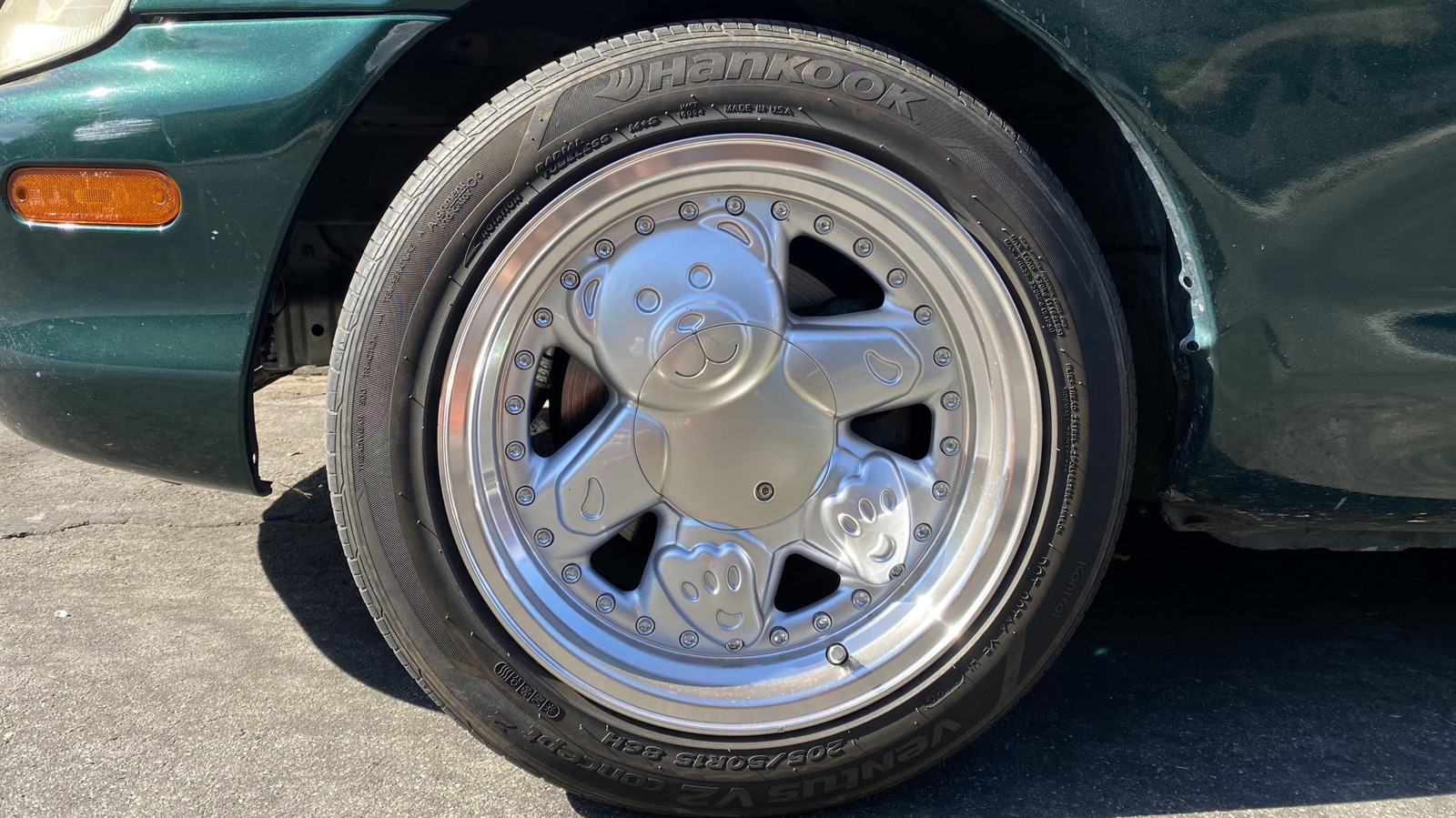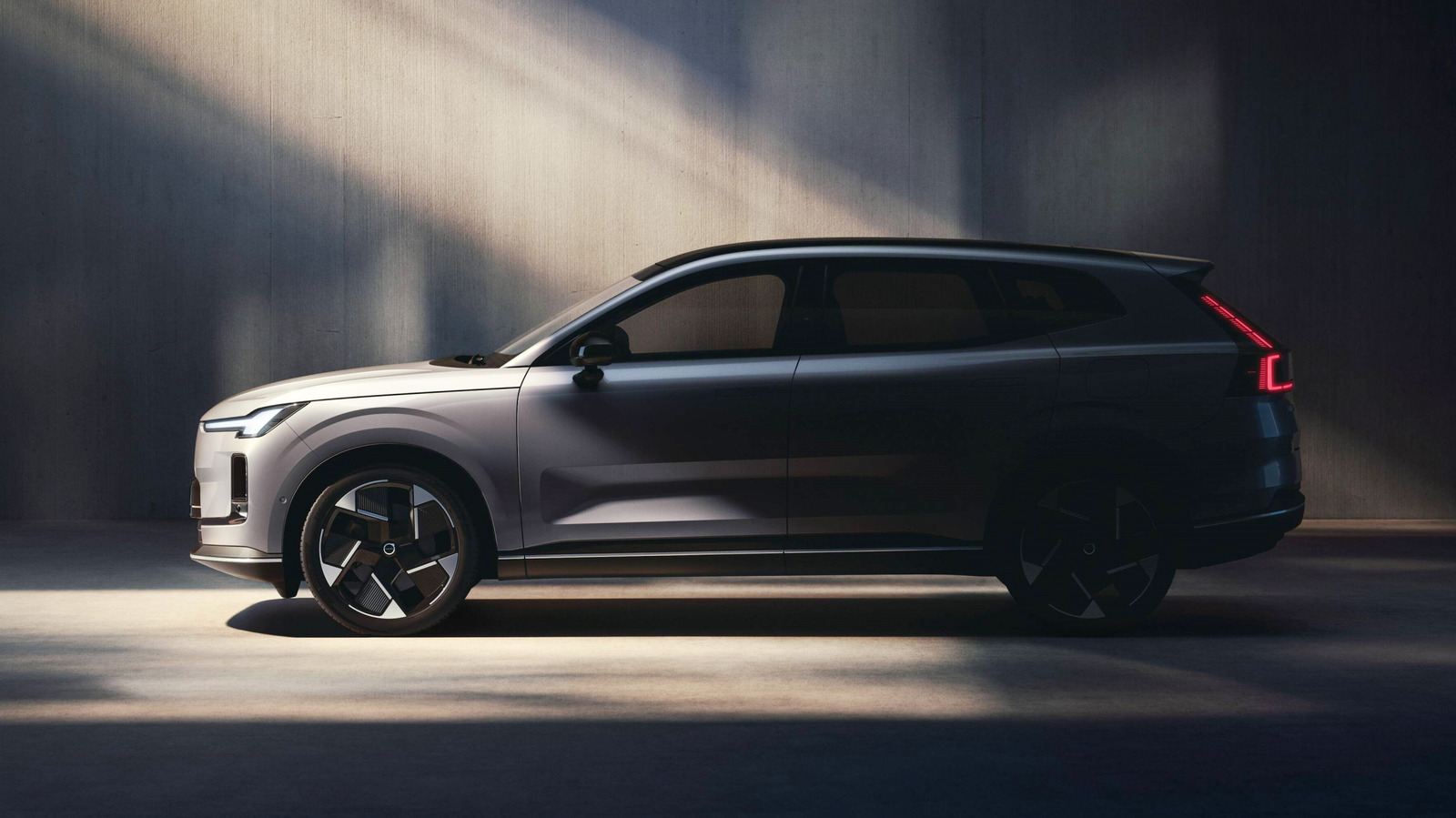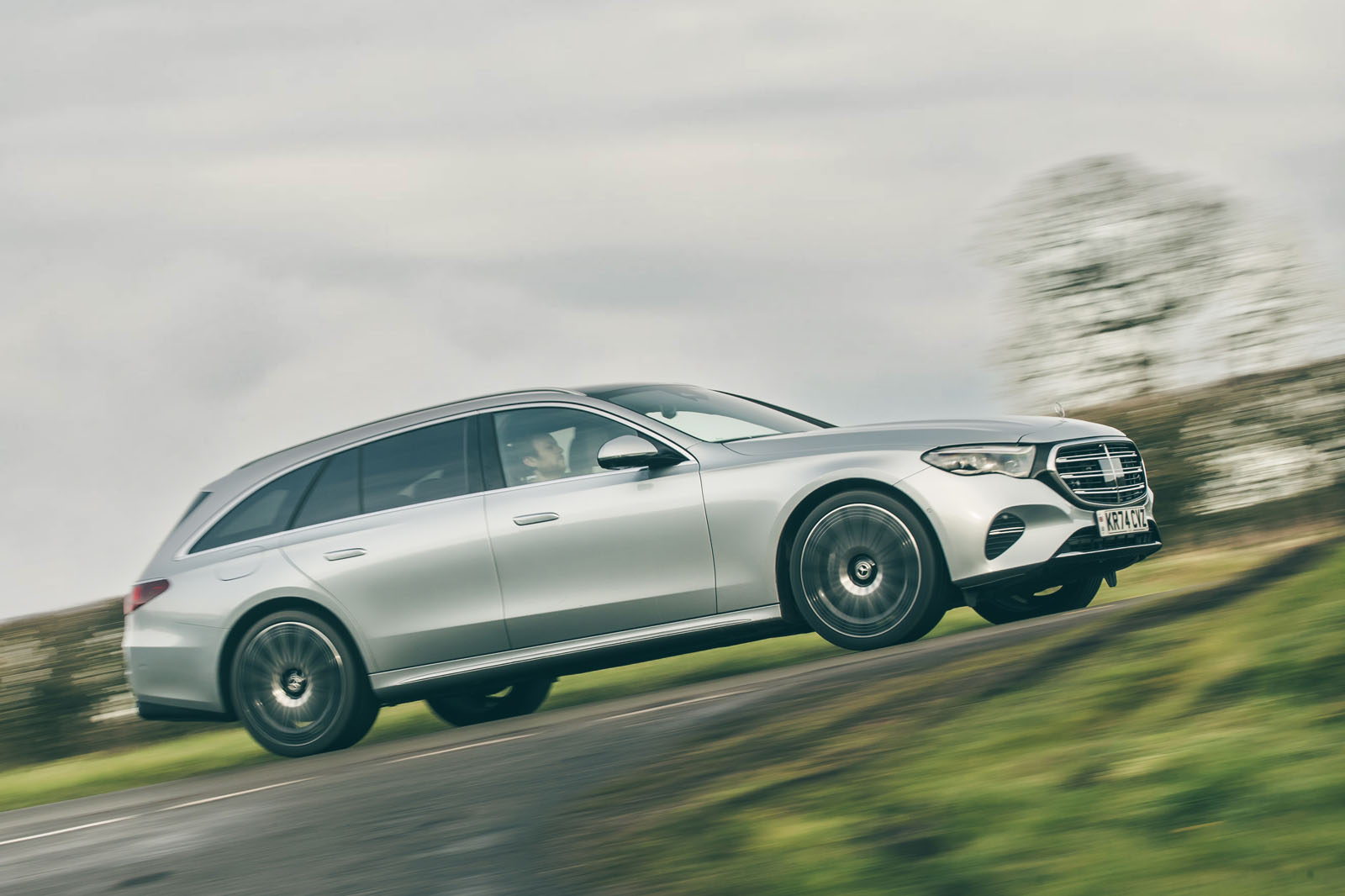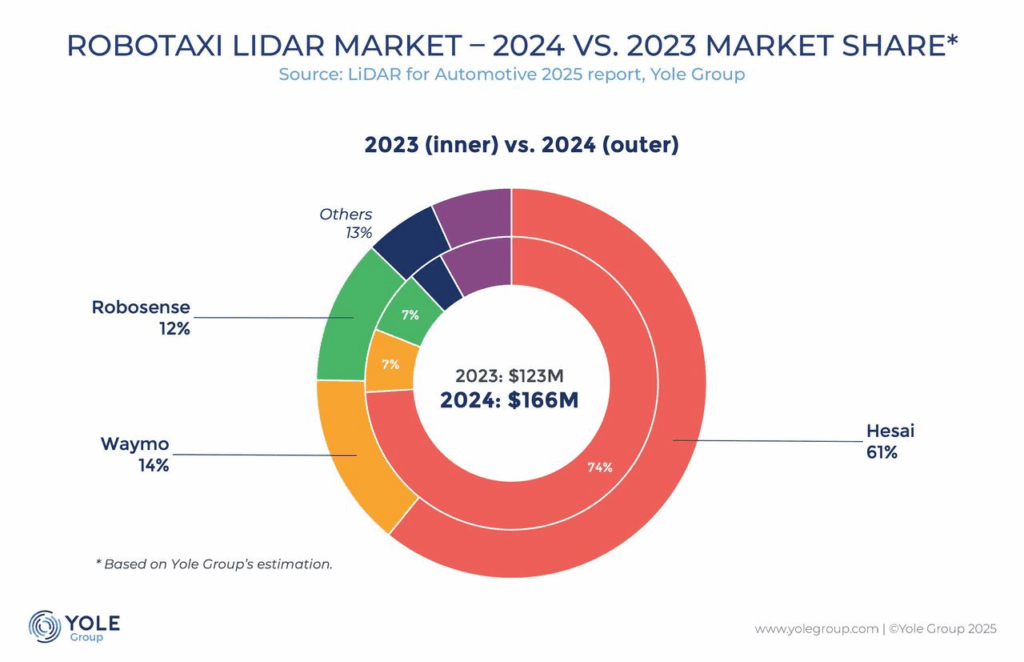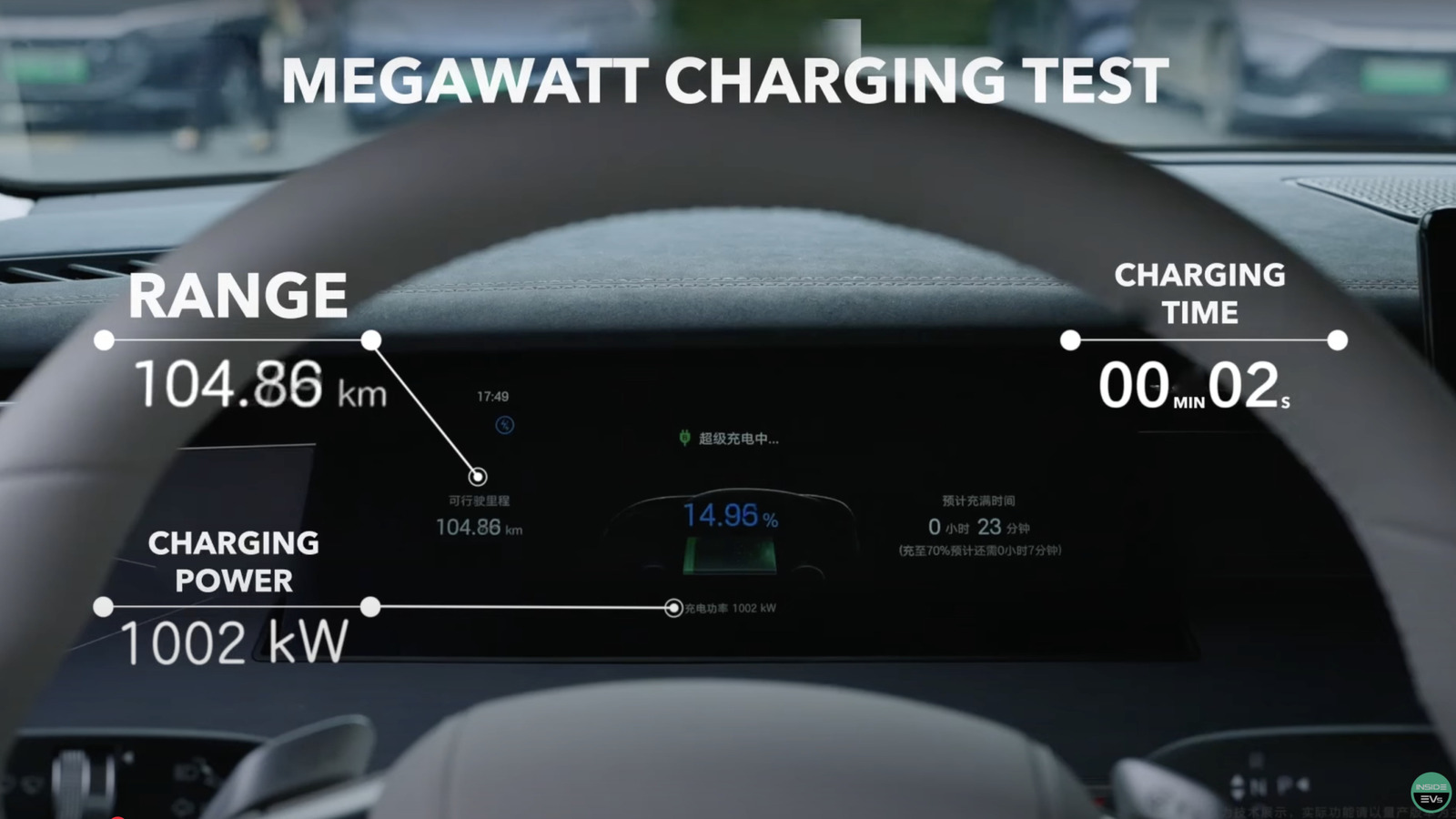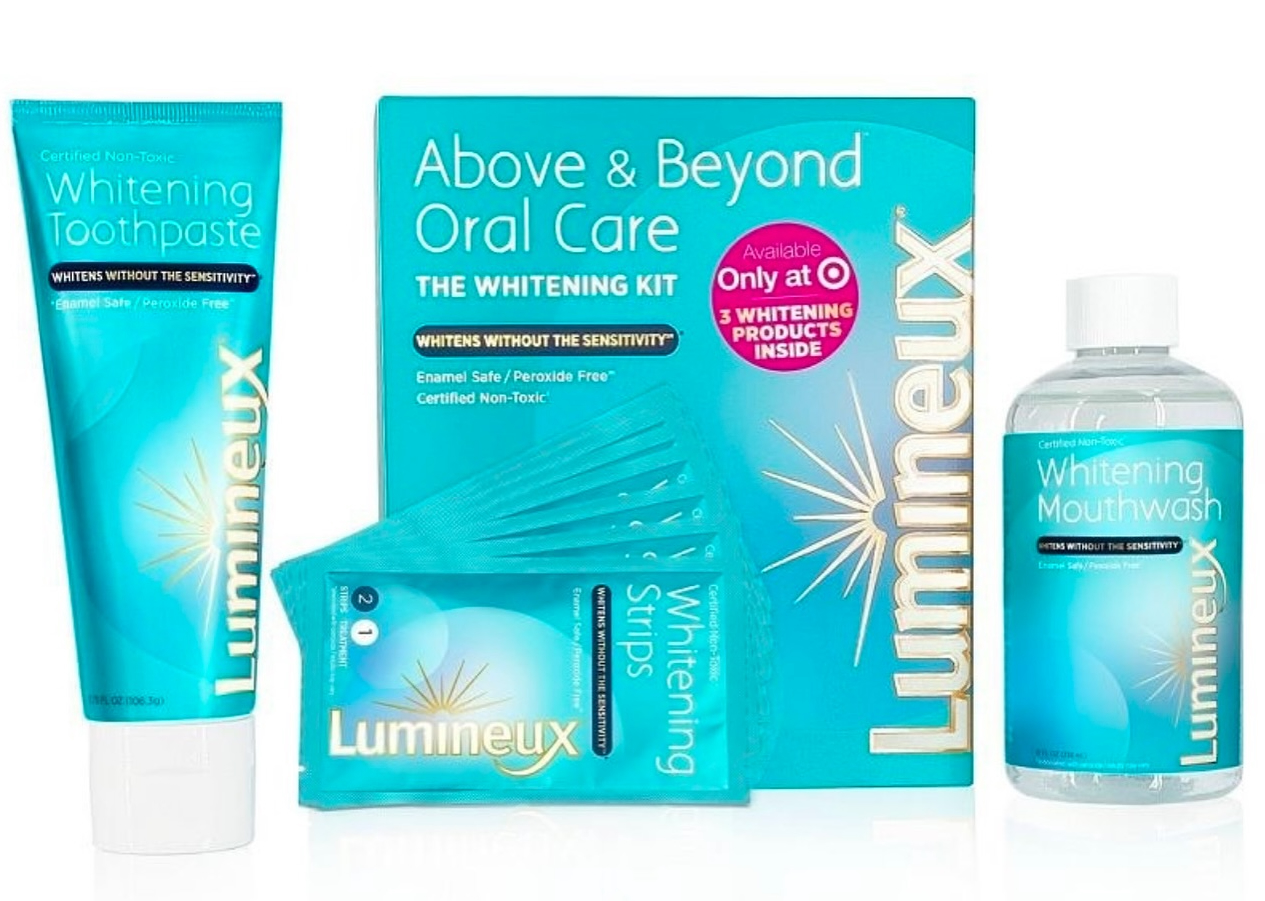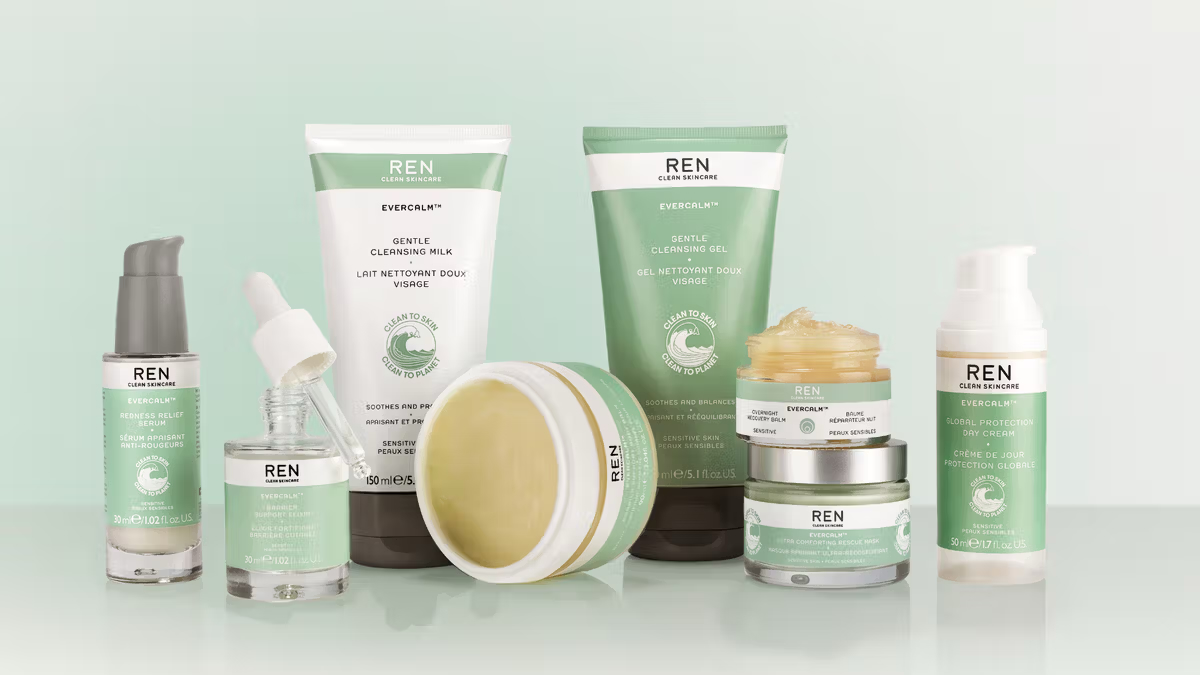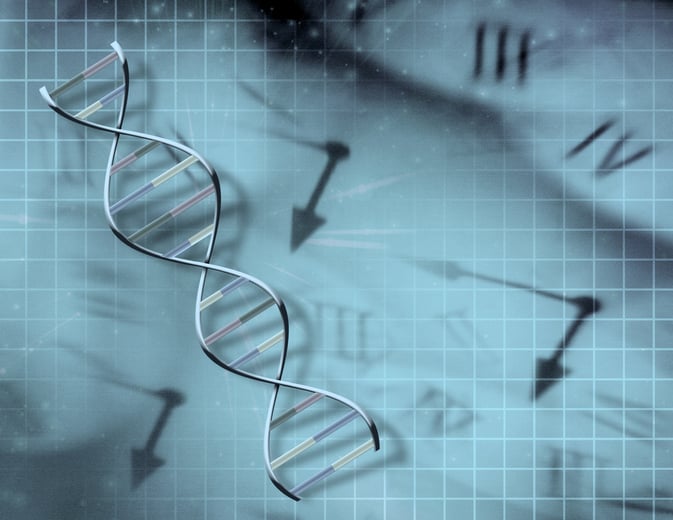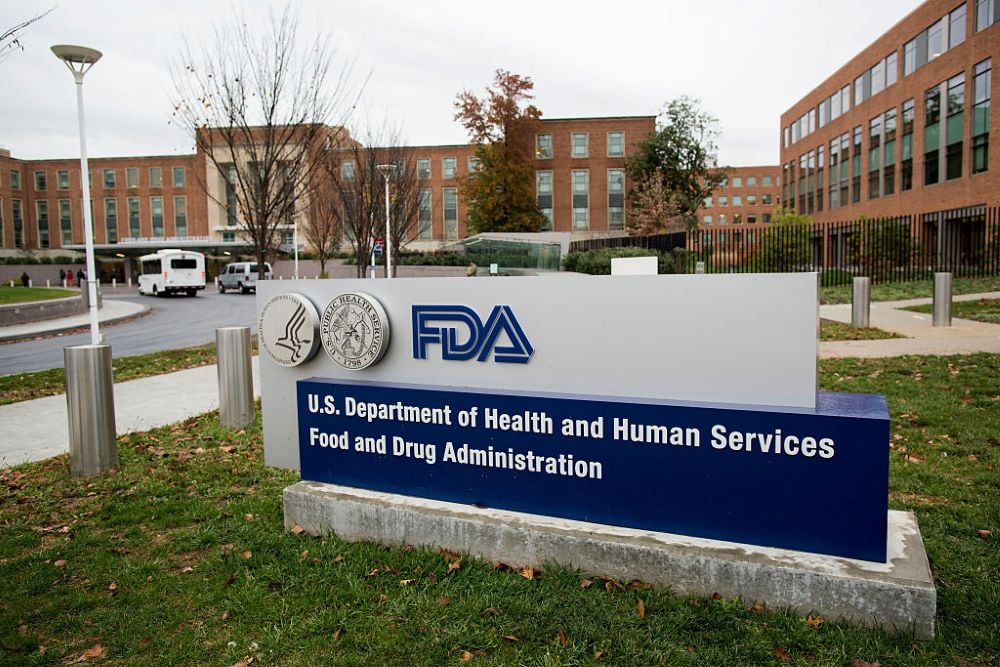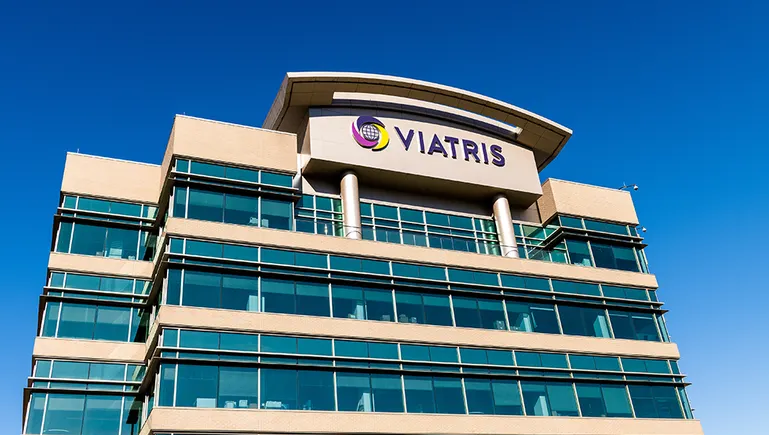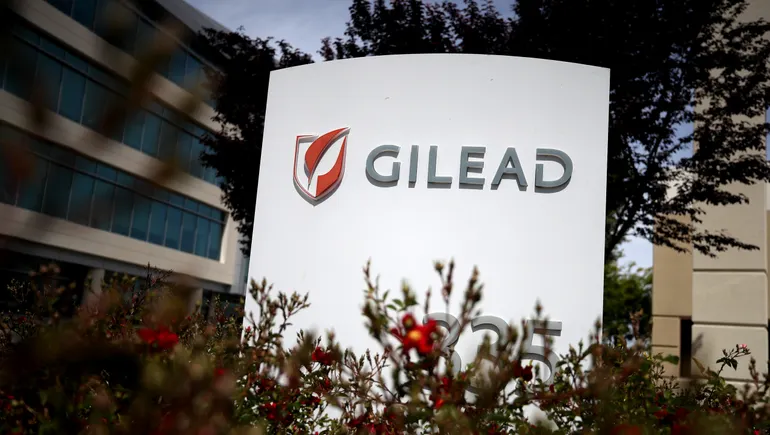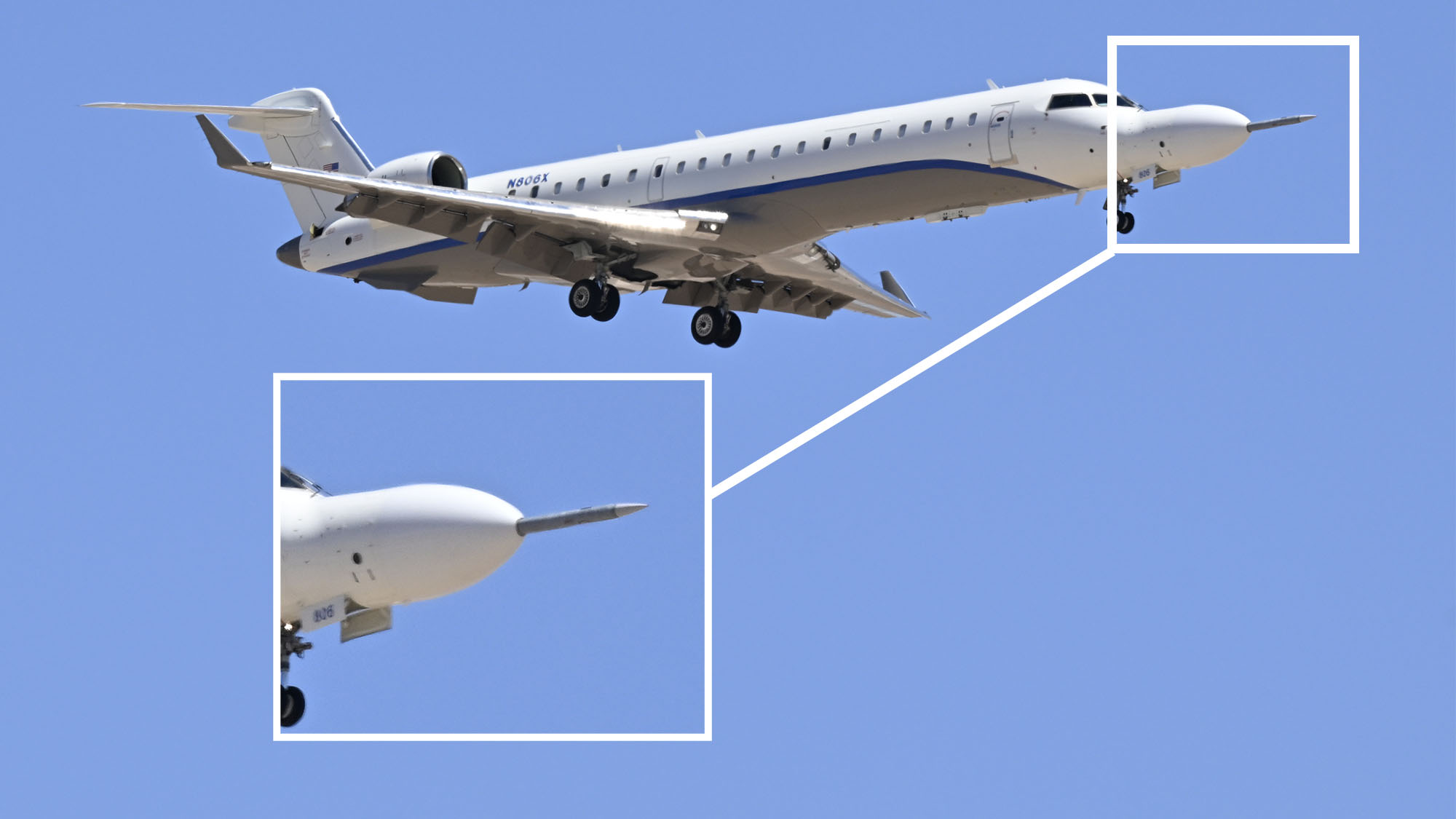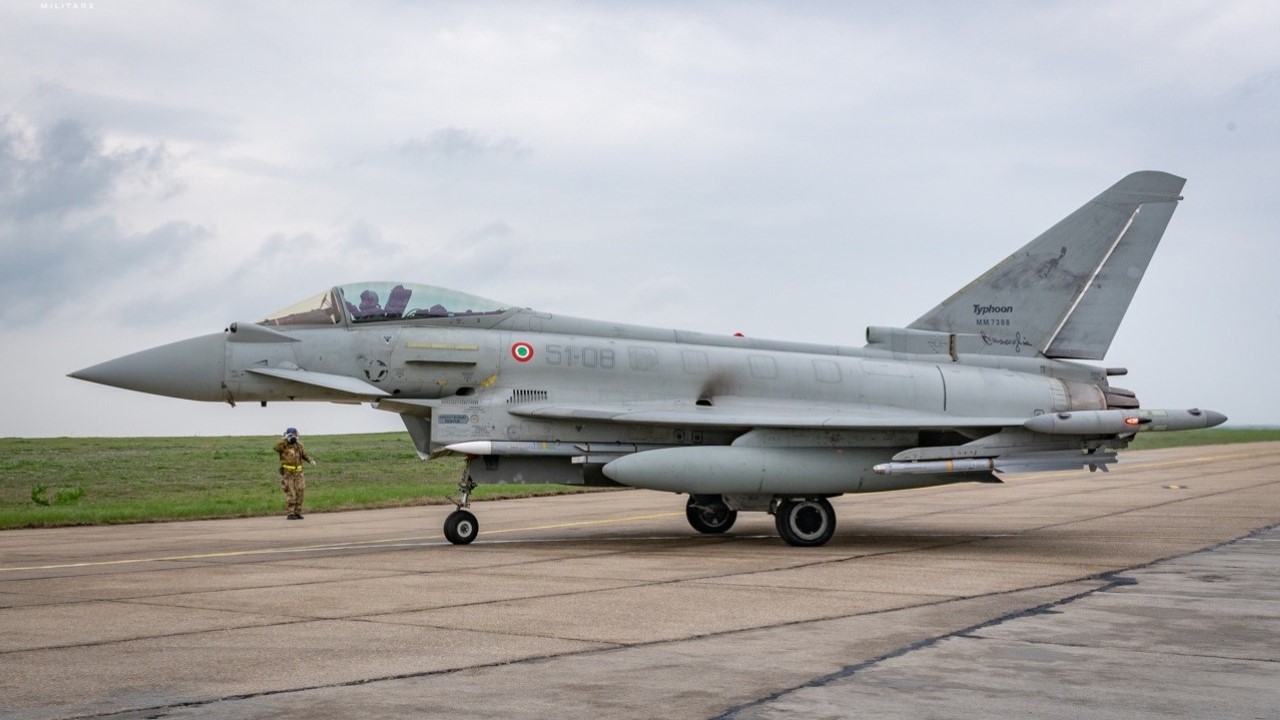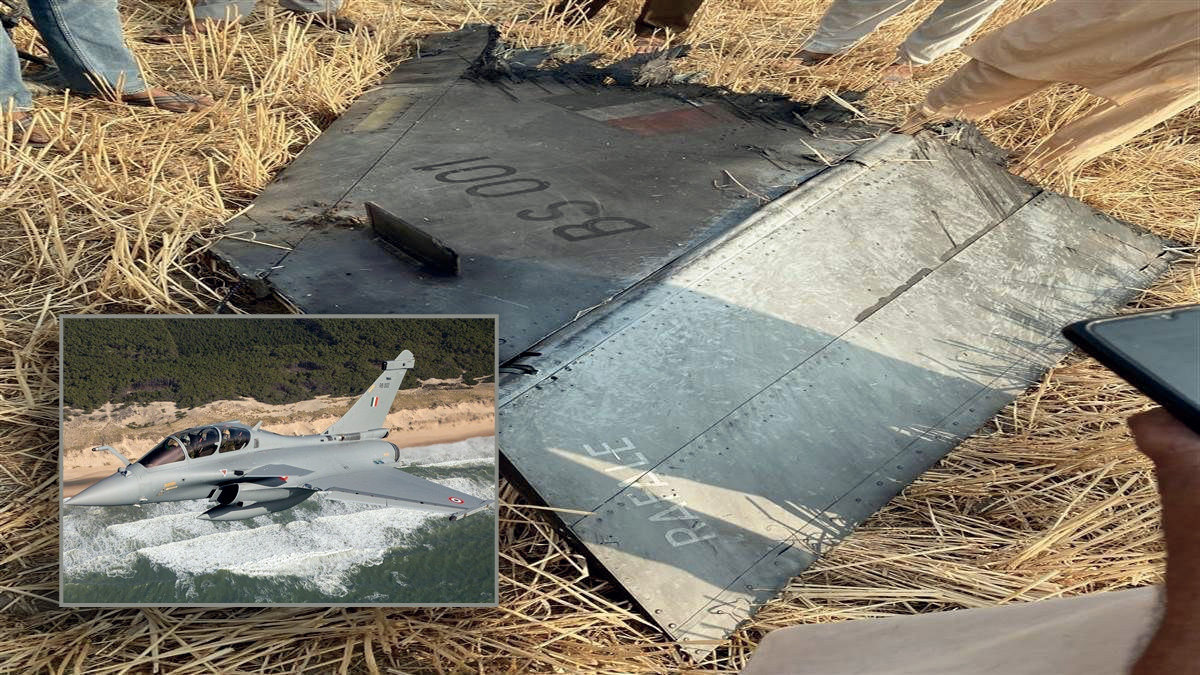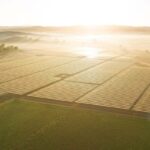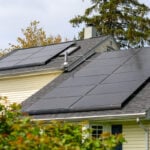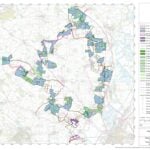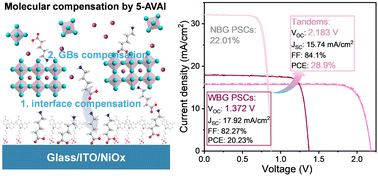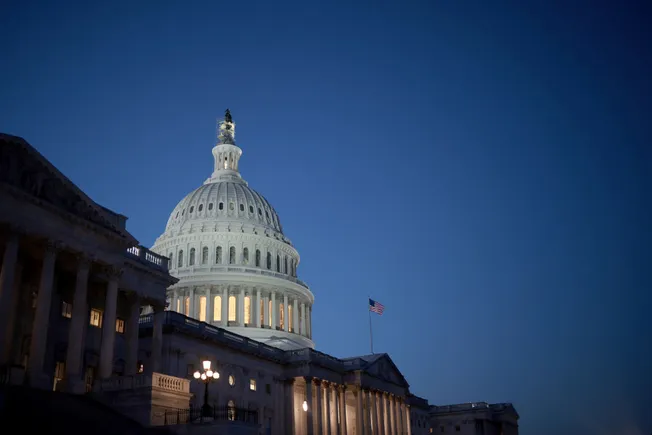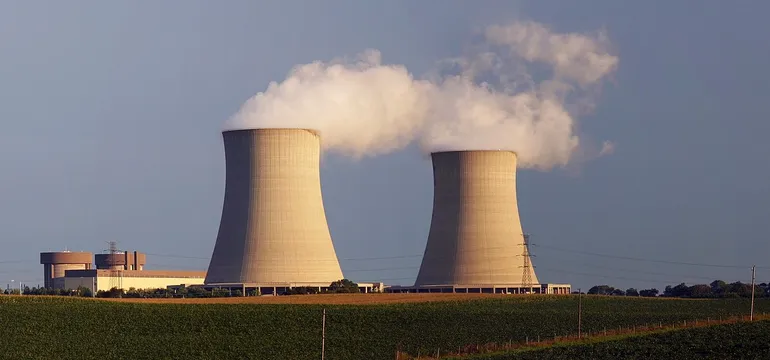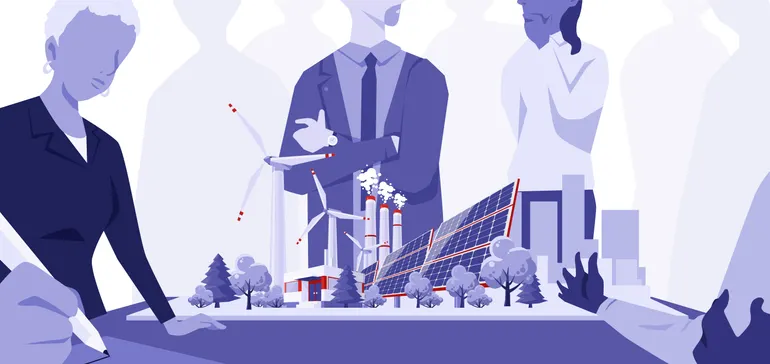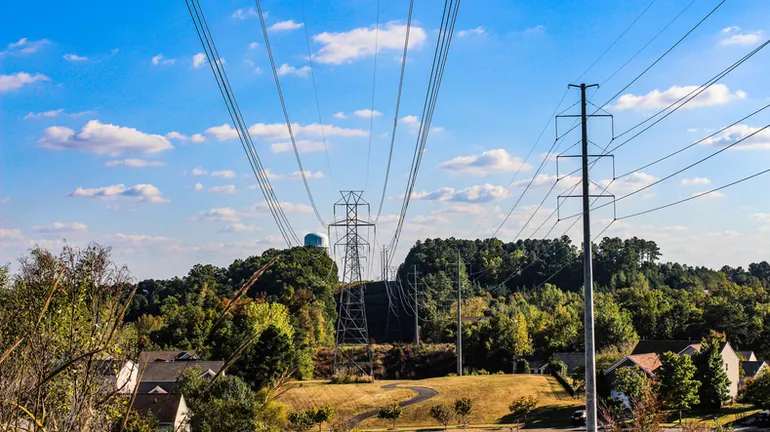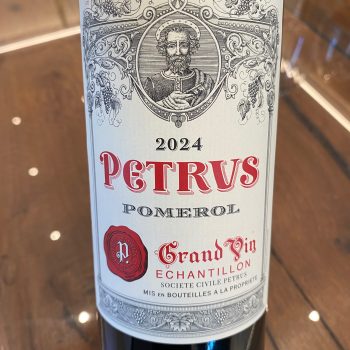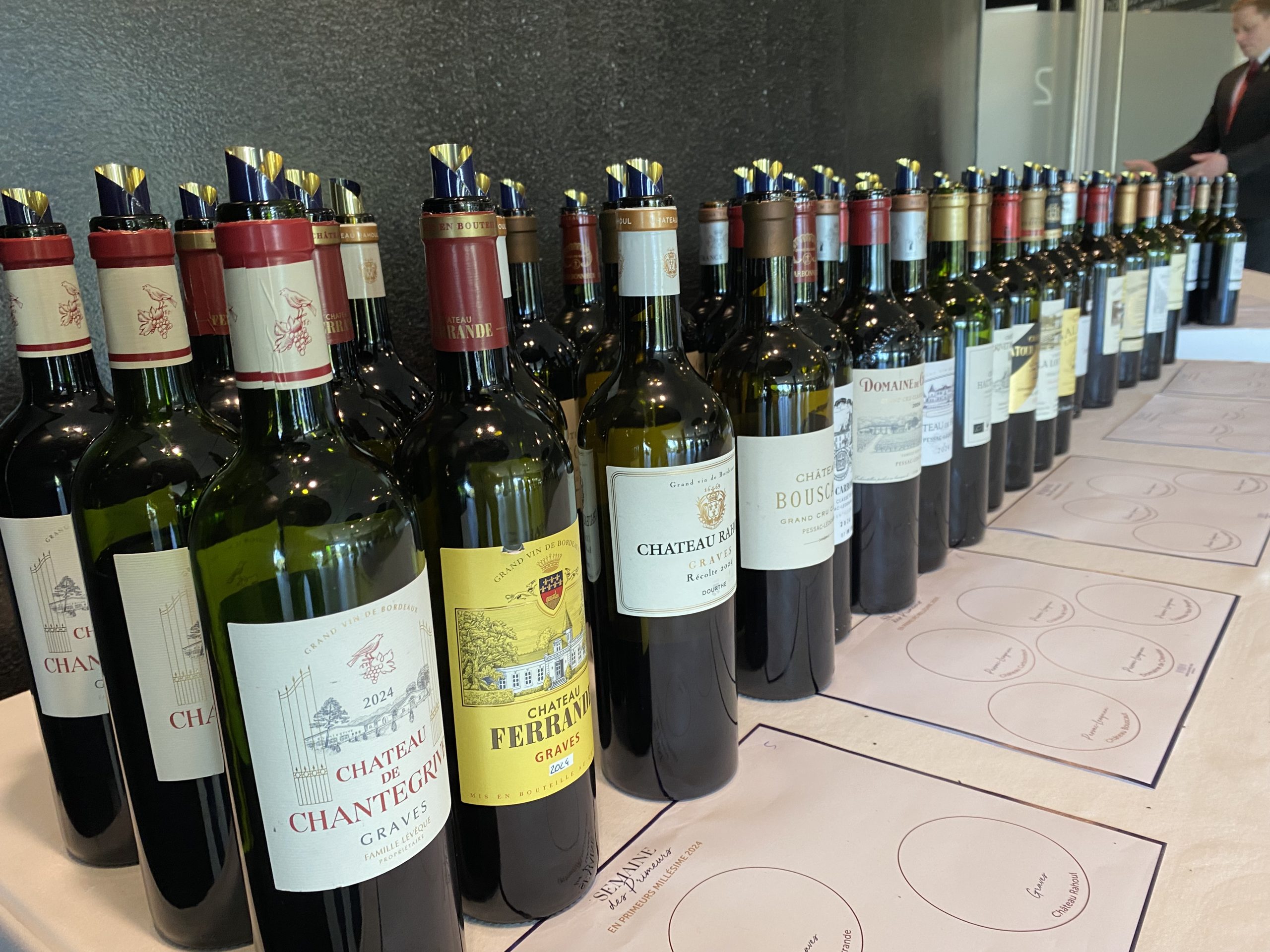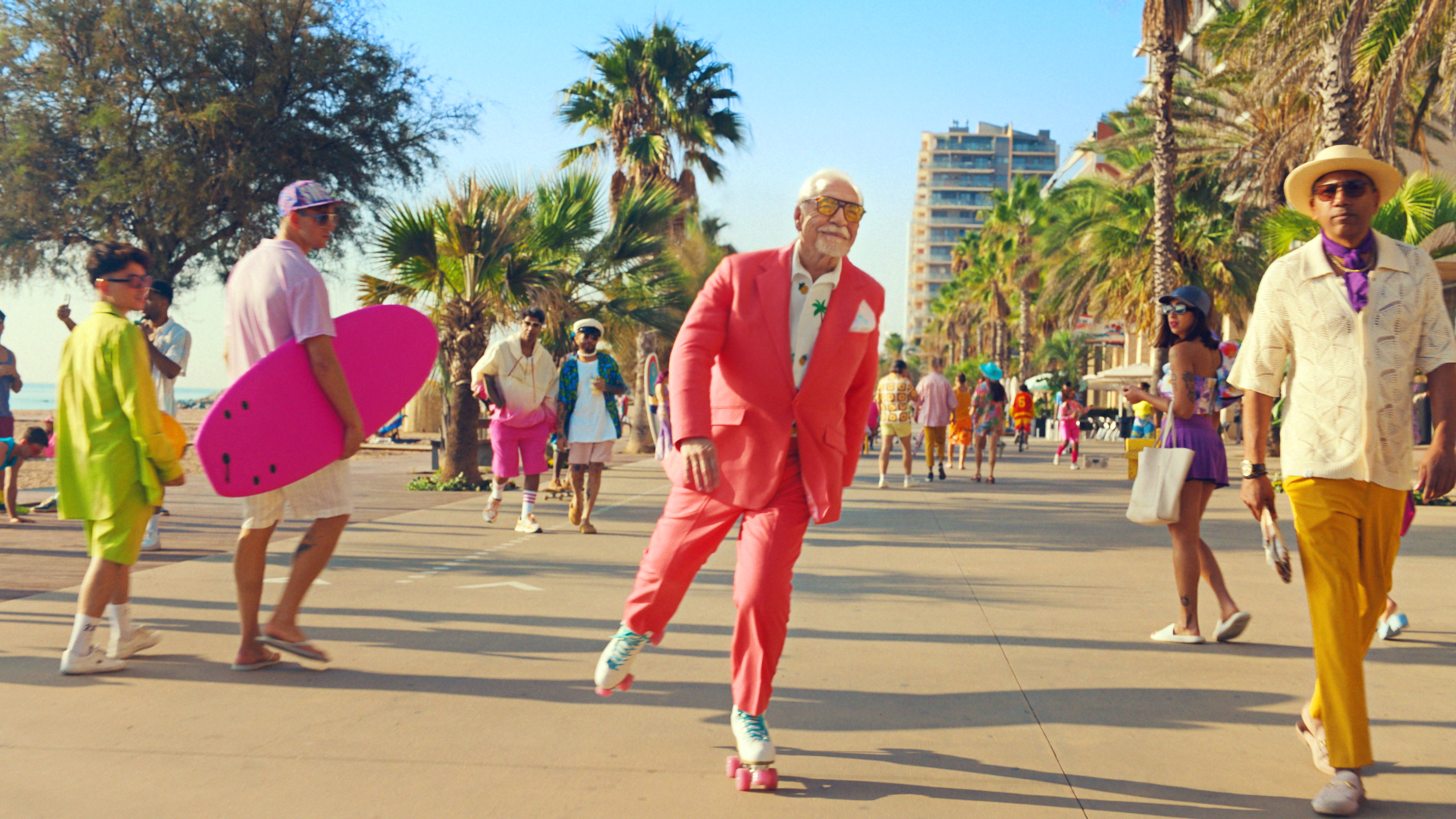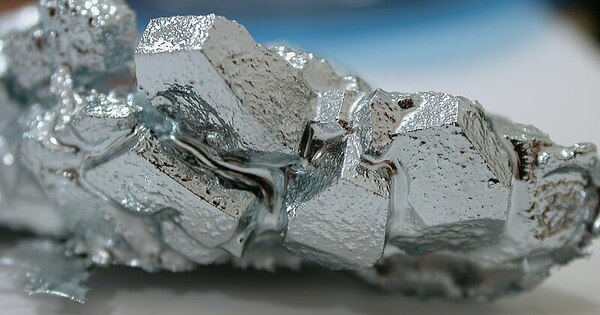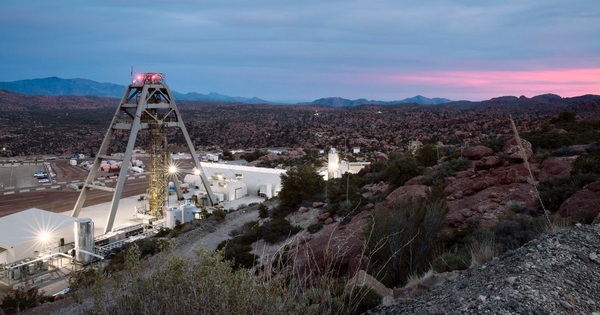Bordeaux 2024 may be rather stronger and more distinct a vintage for the whites than the red, writes db's Bordeaux correspondent Colin Hay, but it remains uneven, despite some spectacular wines at the top end.
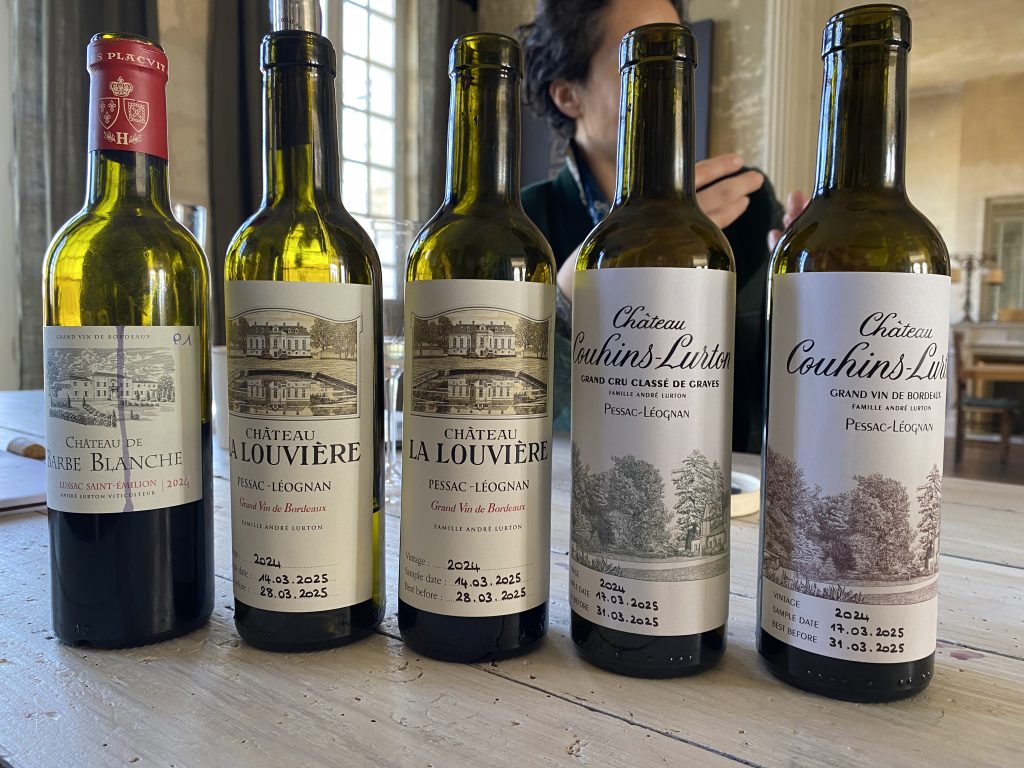 A note on the ratings
A note on the ratings
Alongside the published tasting notes is an indicative rating for each wine and although both comments and ratings are subjective, I would urge you to look at the two together and, if anything, to privilege the comment over the rating. My aim is more to describe the wine in the context of the vintage, the appellation and recent vintages of the same and similar wines, rather than to judge the wine per se.
The ratings reflect my subjective evaluations and relative preferences between wines and obviously your palate is likely to differ from mine. But I hope my comments give you at least enough information to be able to recalibrate my ratings and, in so doing, to align them more closely to your own palate
2024, like both of its predecessors is far from a homogeneous vintage and, consequently, my ratings span a considerable range. I see little interest, either for the consumer or the producer, in publishing very low scores, so I have decided not to publish scores for classed growths (or equivalent wines) rated below 90 (or 89-91 as a range) and for crus bourgeois (or their equivalents) rated below 88 (or 87-89). Where no rating is published, the wine would have scored below these thresholds.
Finally,
élevage is likely to be very important in determining the quality in bottle of these wines. I am no soothsayer and cannot predict how that will turn out (another reason for the use of banded ratings). But all
en primeur ratings should be treated with caution and taken with a certain pinch of salt.
Detailed tasting notes (from over 100 wines tasted)
Graves & Pessac-Léognan
Château Bouscaut (Pessac-Léognan; 80% Sauvignon Blanc; 20% Sémillon; a final yield of 39 hl/ha; 13% alcohol; Thomas Duclos is the consultant here and this feels like one of his ‘project’ wines; tasted twice, the first time with
Sophie Lurton & Laurent Cogombles and then at the UGCB Press tasting). Greengage, gooseberry and cut grass, green tea, lime and lime zest and lily of the valley. Wondrously intense on the attack, with lots of depth and substance over quite a narrow frame accentuating the impact and yet still giving the biting fresh fruit space in which to circle and undulate and ripple and dance. This is very dynamic and energetic in the mid-palate and represents quite a change in style (certainly when taken together with the 2023). Crystalline in its purity, this is perhaps for me the best recent vintage of Bouscaut.
92-94.
Château Cantelys blanc (Pessac-Léognan; from Daniel & Florence Cathiard). One can see the family resemblance with Smith Haut-Lafitte here immediately. This is rich and quite creamy, with lots of peachy fleshy substance and generous citrus acidity to prevent things from getting out of hand. A nice balance, if a bit of a fine wire balancing act – this is close to being too rich for my taste even in quite a fresh and crisp vintage like this. Linden and candlewax linger long on the finale.
88-90.
Château Carbonnieux blanc (Pessac-Léognan; 67% Sauvignon Blanc; 33% Sémillon; a final yield of 40 hl/ha; 12/5% alcohol; tasted twice, first at the UGC press tasting at the Cité du Vin). Saline, with distinct notes of iodine and oyster shell too; almost a hint of smoky bacon crisps (an odd one I know!). White currant, gooseberry, greengage and maybe a little Mirabelle – but it’s fresher than that implies. There’s a little white pear too. Linden and lime. I like the lithe and sinuous mouthfeel accentuated by the sense of viscosity and I like too the trace of limestone tannin that helps shape the finish. This has me craving oysters, just as it should, though it’s perhaps not the most complex of vintages of this wine.
90-92+.
Château Chantegrive Cuvée Caroline (Graves; 50% Sémillon; 50% Sauvignon Blanc). This is always a step up from the larger volume production standard bottling, usually because of the greater selection and the additional oak influence. Here it’s much more about the former and also the greater proportion of Sémillon in the blend. Peach, apricot skin and those lovely crunchy gooseberry and white currant notes from the standard white bottling. Beaswax, honey and a slight -esque note too. Likely to be great value as ever.
89-91.
La Clarté de Haut-Brion blanc (Pessac-Léognan; 64.5 Sémillon; 35.5% Sauvignon Blanc; a final yield of 38 hl/ha; pH 3.23; a final yield of 38 hl/ha; 13.15% alcohol; tasted at La Mission Haut-Brion). Intriguing. Distinct. Floral, but I can’t quite nail the descriptor. Green tea, black tea leaf, white melon,
citron pressé, elderflower and orange blossom, a hint of candlewax. Cool, fresh and intense on the attack, that impression intensified by the narrow frame and the forward thrust on the palate from the attack. Quite intense, dense and concentrated, yet always fresh and always charged with acidity. Maybe lacking just a little complexity, but nicely achieved and very expressive of the vintage.
91-93.
Le Comte de Malartic blanc (Pessac-Léognan; 66% Sauvignon Blanc; 34% Sémillon; a final yield of 41 hl/ha; aged in oak barrels, 10% of which are new; pH 3.28; 12.5% alcohol; tasted at the property). Freshly cut grass, nettles, confit lemon. On the palate, c
itron pressé predominates, with a little mandarin and pink grapefruit, maybe a touch of guava. Fresh, clean and with plenty of crunchy, bright, fresh-fruited acidity. A touch of Malartic white florality and a certain fleshiness on the mid-palate.
87-89.
Château Couhins blanc (Pessac-Léognan; 96% Sauvignon Blanc; 4% Sauvignon Gris; a final yield of 40 hl/ha; 12.8% alcohol; certified organic tasted twice with consistent notes). Wonderfully chiselled, intensely vertical and sublimely tense and fresh, lively and energetic this is the epitome of what makes this a great vintage for the dry whites on these kinds of terroirs and in the hands of great technicians. This is glorious already with those lovely zesty notes, orange blossom too and a hint of green tea and yuzu, almost even a touch of grated ginger, but it will age effortlessly too. Radiantly sapid and grippy on the finish in a way that wonderfully refreshes the palate. Excellent.
93-95.
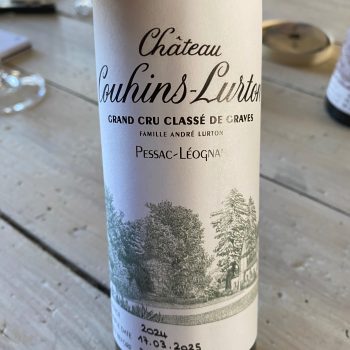 Château Couhins Lurton blanc 2024
Château Couhins Lurton blanc 2024 (Pessac-Léognan; 100% Sauvignon Blanc; a final yield of 41 ha/ha; 13% alcohol; Valérie Lavigne is the consultant here as for La Louvière; tasted twice, first at the property). More wild in its aromatics than, say, La Louvière. Almost a touch of tomato stalk and redcurrant and white currant leaf. Lemon meringue pie.
Citron pressé. White grapefruit. Delicate white spring flowers. Jasmine too and a little elderberry. Green tea leaf, almost a hint of toasted rice. There’s salinity even on the nose. So intense and compact and structurally tense. Really juicy and fresh and sapid. This is the style of Pessac that I really love, with no demonstrative hint of the oak. Great aging potential. A vintage that really shows off the style of this terroir – so racy and fresh and bright and vividly energetic. The limestone bedrock here really sings!
93-95.
Domaine de Chevalier b
lanc (Pessac-Léognan; 75% Sauvignon Blanc; 25% Sémillon; a final yield of 48 hl/ha; pH 3.13; 12.8% alcohol; tasted twice, first at the UGC press tasting at the Cité du Vin). This is lovely. Distinctive, aromatically, with white flowers, nectarine, pear and white melon flesh accompanied by pink grapefruit, blood orange, orange blossom and honeysuckle. There’s a little note of blanched almond and also the creaminess that comes with that. Fine and delicate in the mouth, with a layered sapid freshness but also plenty of density and viscosity (if not that of some recent vintages), rendering this highly tactile and all the more engaging for that. Taut and tense, racy and vibrant.
93-95.
Château Ferrande blanc (Pessac-Léognan; 40% Sauvignon Gris; 36% Sémillon; 24% Sauvignon Blanc; pH 3.3; 12.5% alcohol; tasted twice, first at the UGC press tasting at the Cité du Vin and then at Montlabert; Julien Belle from Oenoteam is the consultant here; certified organic). In comparison with de Chantegrive (tasted just before) this seems to have more Sémillon, giving richness and also greater fruit complexity. Pretty aromatically, with peach, nectarine, apricot skin and assorted bitingly fresh citrus notes –
citron pressé but also confit lemon and even lemon meringue pie, passionfruit and guava, and those little Sauternais notes so characteristic of this vintage. This is lithe, engaging and dynamic in the mouth, sapid and juicy on the finish.
90-92+.
Château de Fieuzal blanc (Pessac-Léognan; 70% Sauvignon Blanc; 30% Sémillon; a final yield of 40 ha/ha; alcohol; tasted twice, first with Stephen Carrier at the property a week after the final assemblage). Very true to its style. Waxy, open-textured, very fine and refined. Saffron, yellow flowers, buttercups. Acacia. A little toasted almonds. Mimosa. Elderflower. Even a little rose petal. There’s lovely hint of peach, peach stone and apricot. Stricter than the 2022 and more like the 2021 in a way, this is beautifully shaped – an hourglass on its side. Tender. Fluid. Beautifully sustained by the granular acidity, rippling towards the finish and then releasing sapidity and juiciness. Very pure yet with a certain opulence despite the structuring and structural acidity. Less strict than many of the wines of the vintage and more aerial and ethereal for that.
93-95.
Clos Floridène blanc (Graves; 55% Sémillon; 45% Sauvignon Blanc; 13% alcohol). Ample on the attack and layered, almost like a cascading cliff face made of well-defined vertical strata, each here interspersed with juicy, sapid confit and freshly squeezed citrus notes. Radiant and luxurious in its precision and in its glassy mid-palate this is likely to prove exceptional value – not for the first time.
90-92.
Château de France blanc (Pessac-Léognan; 80% Sauvignon Blanc; 20% Sémillon; a final yield of 40 hl/ha; 13% alcohol; tasted first at the UGC press tasting at the Cité du Vin). Lithe and limpid, racy and energetic, with the tension and tautness that is the signature of this wine reinforced by the relatively narrow frame. Not terribly complex, but finely judged and accessible immediately.
89-91.
Château La Garde blanc (Pessac-Léognan; 93% Sauvignon Blanc; 7% Sémillo; 13% alcohol; Axel Marchal is the consultant here). Interesting aromatically. Eucalyptus. Incense. Ginger – fresh and confit. Apple, peach, apricot and nectarine, and then 50 shades of citrus. This has a pleasing sense of structural tension, reinforced by the gentle touch of tannin on the finish. Super sapid on the finish.
91-93.
Château Haut-Brion blanc (Pessac-Léognan; 56.1% Sémillon; 43.9% Sauvignon Blanc; pH 3.22; a final yield of 38 hl/ha; 13.75% alcohol; tasted at La Mission Haut-Brion). Orange blossom. Jasmine. Candlewax. Richer, fuller, maybe a little less ample in frame and with more profundity as a consequence, this is a
grand vin blanc de garde. Green tea notes, with a little yuzu, some exotic guava and even mango notes. Rich, full and viscous but in this vintage never lacking in freshness and incisive acidity. Tender and more grippy on the finish that La Mission blanc, but actually richer too. Quite toasty for a young Haut-Brion. Assorted white fleshy fruits – pear and pear belle Helene and also a little, but very subtle, note of apricot and nectarine, even the suggestion of wild strawberry. I like the cascading ripples of freshness that seem to descend from above. Saline on the finish.
94-96.
Les Hauts de Smith (Pessac-Léognan; 100% Sauvignon Blanc; 50% new oak; tasted at the property). Glassy, glossy, rich and dense but hyper-fresh and intensely sapid and juicy. Easy, not especially complex I guess, but wondrously refreshing and impressively viscous in the mouth too. Excellent at this level and at its likely price point. Crunchy white fruits and
citron pressé.
90-92.
Château Larrivet Haut-Brion (Pessac-Léognan; 84% Sauvignon Blanc; 16% Sémillon; 13% alcohol; tasted twice, first at the UGC press tasting at the Cité du Vin). This is excellent and rather different. Peach and nectarine, a hint of wild strawberry, wild spring hedgerow flowers, fennel tops, freshly cut grass and a hint of exoticism – guava and passionfruit, passionflower too. Freshly grated ginger. But also a distinct oak smoke note. Intense, lifted and aerial and very vertical in its mouthfeel, with a lovely grip from the trace of tannin as an undertone. I like this a lot.
93-95.
Château Latour Martillac blanc (Pessac-Léognan; 60% Sauvignon Blanc; 40% Sémillon; a final yield of 52 hl/ha; 12.5% alcohol; tasted twice, first at the UGC press tasting at the Cité du Vin). Jasmine, honeysuckle, apricot and nectarine,
citron pressé and
tarte au citron. A little blanched almond and also fennel fronds. This is exquisite and, rather like Larrivet Haut-Brion tasted alongside, it has a very vertical, almost hour-glass shape in the mouth. Tactile and dynamic and ultra-refreshing in its sapidity, this is a great success. I love the zestiness of the finish.
93-95.
Château La Louvière blanc (Pessac-Léognan; 100% Sauvignon Blanc; a final yield of 43 ha/ha; 13% alcohol; Valérie Lavigne is the consultant here; tasted first at the property, then at the UGC press tasting). Apple core. White grapefruit. A little white peach flesh – just
à point. Nettle and greengage. Lemon confit. White flowers. This is richer aromatically than Couhins Lurton but it takes a while to open fully. It’s fleshier on the palate and with a slightly more open texture too. Crystalline, fresh, pure and very well defined in its linearity with a clear and evident central spine. Zesty. Clementine peel. Very fresh and gloriously sapid, with a lovely salinity to the finish. This already has me craving oysters.
91-93+.
Château Malartic-Lagravière blanc (Pessac-Léognan; 69% Sauvignon Blanc; 31% Sémillon; a final yield of 41 hl/ha; 40% new oak; pH 3.28; 12.5% alcohol; tasted at the property with Severine and Jean-Jacques Bonnie and then re-tasted at the UGC press tasting). Beautifully true to its style and an easy pick. Upright, tense and charged with energy. A touch of iodine and oyster shell, gooseberry, greengage and Mirabelle, green tea, white almond. Apple skin. This has great impact on the attack with lots of vertical range and layering for a white. Some exotic fruits– guava and passionfruit – but predominantly citrus notes, with blood orange, mandarin rind, yuzu and pink grapefruit; white pear and nectarine too. A little fennel bulb. This has a lovely subtle salinity on the finish too. Long and gently tapering. lhere’s pots of aging potential to this but it’s already highly accessible – frankly, deliciously crisp. Apple skin on the finish and a gentle touch of tannin.
92-94.
Clos Marsalette Blanc (Pessac-Léognan; 54% Sauvignon Blanc; 46% Sémillon; a final yield of 50 hl/ha; 13% alcohol; tasted at Canon-La-Gaffelière). This has a lovely ample frame, once again, but it’s also hyper-fresh and gloriously energetic and fruity. The Sémillon brings a lovely pure peach fruit and lots of succulence with it. Apple skins. Confit lemon. White melon. A touch of passionflower too. Enticing and racy. Salivating in its sapidity.
90-92+.
Château La Mission Haut-Brion blanc (Pessac-Léognan; 5% Sémillon; 41% Sauvignon Blanc; pH 3.25; a final yield of 38 hl/ha; 13.75% alcohol; tasted at the property). Linden. Lime leaf. Lime zest. Elderflower and even a little elderberry. Cathedral candles and the plume of smoke from the candle snuffer. White pear. A touch of guava – a note that returns on the palate and that slight La Mission exoticism that could almost have us in the kingdom of Sauternes in terms of fruit descriptors. This is crystalline in its purity and precision, radiant and dynamic in the flow of the fruit and the sapidity of the up-flows and resulting eddies of freshness to be discovered in the mid-palate. Very beautiful and very poised, but at the same time a
vin de garde that one really needs to cellar. Fresher and more energetic in than freshness and sapidity than Haut-Brion, fresher still with more zest and vim from a second bottle newly opened.
95-97.
Château Olivier blanc (Pessac-Léognan; 80% Sémillon; 20% Sauvignon Blanc; a final yield of 51 hl/ha; 13% alcohol; tasted twice, first at the UGC press tasting at the Cité du Vin). Orange blossom, honeysuckle, a hint of saffron and a cascade of citrus. A little confit melon too. Very crisp and bright, energetic and aerial, yet with a lovely sense of structure, forged as much by the acidity as by anything else. This has a pronounced sense of freshness like a firehose pointed upwards in the mouth spraying juicy sapidity so that it descends down the cheeks. A lovely harmony.
92-94.
Château Pape Clément blanc (Pessac-Léognan; 50% Sauvignon Blanc; 43% Sémillon; 7% Sauvignon Gris; a final yield of 37 hl/ha, just a little below the appellation average; tasted twice, first at the UGC press tasting). Wonderfully true to its style and simply wonderful once again in this vintage. We’ve got a lot more of the exotic notes of the vintage here – guava and pineapple, alongside the more conventional nectarine and white melon, lime and lemon zest and a hint of floral honey and saffron. A signature Pape Clément hint of beeswax. This makes a stark contrast to the grippier, more citrus-oriented and chiselled style of Couhins and Couhins Lurton, but you really want to taste them all. Splendidly juicy and energising in its freshness – that cuts the richness so successfully. That is sometimes my issue with Pape Clément, but not at all in this vintage.
94-96.
Le Petit Smith Haut-Lafitte (Pessac-Léognan; 80% Sauvignon Blanc; 20% Sémillon; 50% new oak; tasted at the property). Le Petit is Grand in 2024,
un grand vin de table! Granny Smith apple! Iodine, oyster shell, linden, lime and assorted fresh and confit citrus notes. A touch of confit lemon too. Really ample and pushing at the cheeks, like it’s bigger sibling. Lovely sapidity with little plumes of fresh citrus descending like tears down the side of the wine glass.
91-93.
Château Picque Caillou blanc (Pessac-Léognan; 100% Sauvignon Blanc; a final yield of 36 hl/ha; 13% alcohol; tasted twice, first at the UGC press tasting at the Cité du Vin). A wine with the misfortune of coming immediately after Pape Clément in alphabetical order in the UGC tasting, but here it shows really well. Pear, pear belle Hélène, blood orange and orange blossom, even a trace of wild strawberry. I love the gentle viscosity – the texture of the finest tomato consommé and, like that, there’s just a hint of tannin on the finish that I really find enticing. Poised, lithe, delicately balanced and very refined. As good a vintage of this as I can recall.
92-94.
Château Smith Haut-Lafitte (Pessac-Léognan; 90% Sauvignon Blanc; 5% Sémillon; 5% Sauvignon Gris; a final yield of 32 hl/ha because of the early mildew pressure; 50% new oak; tasted twice, first at the property and then at the UGC press tasting). Wax candles. Linden. Lime. Jasmine. White floral notes – jasmine and elderflower, a little orange blossom too. Green tea and yuzu. A little peach skin, Granny Smith peel and just a hint of guava in all its essential freshness. Structured by the acidity and a little tannin. Even Macha. No signature of the oak, or very little – just a hint of spice. White peach and the texture of the skin – very tactile. So sapid and juicy. One of the best wines ever from here. A pinch from the tannins and then a release of salinity and even a little sweetness.
95-97.
Bordeaux blanc
Château d’Aiguilhe blanc (Bordeaux blanc; 100% Sauvignon Blanc, with a little Sauvignon Gris, co-vinified; a final yield of 28 hl/ha; 12.5% alcohol; tasted at Canon-La-Gaffelière with Stephan and Ludovic von Neipperg). Very tense and defined by its limestone terroir even in its aromatics. A wine that exudes taut tension. One can imagine the structure of this in the mouth just from the aromatic profile alone. More lime and confit lemon notes, a little white grapefruit too. White pear. So intensely juicy and sapid. A much narrower frame and much more depth and layering as a consquence. Dynamically fresh.
92-94.
Aile d’Argent (Bordeaux blanc; 54.5% Sauvignon Blanc; 33% Sémillon; 12.5% Sauvignon Blanc; a final yield that was good considering the age of vines; pH 3.05; 6.5% malolactic fermentation; 12.8% alcohol; tasted with Jean-Emmanuel Danjoy at Château Mouton-Rothschild). Lovely floral aromatics and a freshness that used never to be very present in this wine. Bright, crisp, dynamic and very lifted. A wine of incredible impact, intensity and purity. We talk often of the acidity cutting the far, here the richness prevents the acidity from dominating, giving it a frame. Fresh and fluid and radiantly vivid and vibrant. Linden. Peach. Pear. Elderflower. White grapefruit. Guava. So divinely glassy and crystalline in texture. Wondrous, and so different to how it used to be.
94-96.
Château de Bellevue Sauvignon Gris (Bordeaux blanc; 100% Sauvignon Gris; this comes from Château de Bellevue in Lussac-St-Emilion; certified organic; Hubert de Boüard consulting). I rather like the idea of this as I do the wine itself. Blood orange juice and zest and then some more of both, with a lovely hint of crumbly limestone tannins giving texture on the finish. It’s not complex, but not everything needs to be.
88-90.
Le Blanc de Duhart-Milon (Bordeaux blanc; 60% Sémillon; 35% Sauvigni Blanc; 3% Sauvignon Gris; tasted at Duhart-Milon with Saskia de Rothschild). Another wine from the Médoc with an almost Sauternes-esque profile aromatically – one is almost waiting for the arrival of the sucrosity on the palate. I love that and I love this. White melon, confit lemon,
tarte au citron, lemon meringue pie, pear, lanolin. Very pure and with a lovely spherical yet ample core, filled with radiating swirling fresh fruits. Dynamic. There’s a gentle touch of tannin just on the finish. A great success, this is a wine of lovely balance and harmony, the acidity producing tension but never destabilising the luxuriance.
92-94+.
Le Blanc de L’Etampe (Bordeaux blanc; 100% Sauvignon Blanc; 13% alcohol; certified organic and biodynamic; Jean-Claude & Jean-François Berrouet are the consultants here). Not perhaps the most inspired of names for a wine, but the wine is inspiring in the fabulous intensity of its fruitiness and its energetic freshness, exuding tension and verticality, lift and interest. Confit grapefruit zest, assorted freshly squeezed citrus juices, a little white melon flesh and the subtlest of hints of sweet spice (the 20% new oak is very subtle, but it's there). There’s a scratch of raw ginger too. Vivid.
91-93.
Le Blanc de Fontenil (Bordeaux blanc; a blend, if I recall correctly, of Sauvignon Blanc, Sémillon, Chardonnay, Sauvignon Gris and Muscadelle). Another
blanc sec that I am tasting for the first time. Lime, linden, white grapefruit and a little ginger and jasmine. Quite plump and rich in its way but thoroughly interpenetrated by veins of sapid juiciness; a perfect accompaniment for oysters, with a hint of iodine and lots of salinity on the finish. It’s a little overt in its oak use for me, but by no means excessively.
89-91.
Blanc de Chateau d’Issan (Bordeaux blanc; 35% Viognier; 35% Rousanne; 20% Marsanne; 10% Rolle; pH 3.2; 13.2% alcohol; tasted at Château d’Issan with Augustin Lacaille). The limestone terroir is crucial here. Lithe and gracious and super expressive in this vintage. Wax. Peach. Nectarine. Lime and lemon juice. White pear. A touch of lime. A hint of ginger. Despite the varietals, the signature element here is the vertical freshness very well distributed and stretching the wine from top to bottom. Blood orange and mandarin zest. Pink grapefruit with a gentle creaminess. A hint of honey.
92-94.
Blanc Sec de Lafaurie-Peyraguey (Bordeaux blanc; 60% Sauvignon Blanc; 40% Sémillon; Valérie Lavigne and Axel Marchal is the consultant here). Beautifully chiselled. 50 shades of citrus, linden and lime. So clear, eloquent, crunchy, bright and crystalline. A touch of wild strawberry and a hint of lanolin. The acidity scrunches the wine as if to squeeze out of it the acidity and that achieves a wondrous tactile contact with the mouth – and hence dynamism. Like an inverted pyramid, with lovely traces of tannin that, with the acidity, pull this towards the base of the mouth. Brilliantly structured and dynamic. Fabulously refreshing.
93-95.
Blanc de Lynch-Bages (Bordeaux blanc; 77% Sauvignon Blanc; 12% Muscadelle; 11% Sémillon; pH 3.12; aged in oak barrles, 50% of them new; 12.5% alcohol; tasted at Lynch-Bages with Jean-Charles Cazes). White grapefruit, confit melon and lemon, gooseberry, a touch of linden and some juicy exotic fruit notes too – passionfruit and passionflower. White current. A lovely trace of tannin on the finish that I really love and that seals the deal. Sapid and intensely juicy. Honestly, this is excellent, the oak seamlessly integrated.
92-94.
Les Champs Libres (Bordeaux blanc; 100% Sauvignon Blanc from Sancerre massal selections, the older vines at 15 years of age now; tasted at Chateau Lafleur with Omri Ram and Baptiste Guinaudeau). Green tea leaf,
citron pressé, white grapefruit, gooseberry, a little peach too, linden and white pear, grated ginger. A touch of elderflower, camomile, even a subtle hint of rose water. Aromatically soft and gentle leading you to expect something much more opulent on the palate. Broad-framed but charged immediately by the acidity and the little granularity of the grippy tannins. An hourglass, with lift and structural depth. So juicy and sapid on the finish.
94-96.
Confidence de Bastor-Lamontagne (Bordeaux blanc). Relatively simple, perhaps, but with a personality all of its own and a finesse that I really like. This is ample and quite glassy on the palate as a consequence, but there’s lots of detail from the fine penetration of the citrus acidity throughout the palate – both vertically, bringing a sense of layering, and horizontally, bringing texture and almost pixilation. I love the blood orange notes here, both aromatically and again on the palate. I find this very pure and well-composed. Contemplative.
89-91.
Château Cos d’Estournel blanc (Bordeaux; 60% Sauvignon Blanc; 40% Sémillon; pH 3.07; aging in oak barrels, 8% of them new; 12.2% alcohol; tasted with Dominique Arangoits at Cos). Almost Sauternais in terms of its aromatics. Lanolin. Peach, pear, yuzu, elderberry and jasmine. A little ginger, freshly grated, and lemongrass too. This is a study in tension – between the colossal horizontal range and the acidity that seeks to demolish it vertically (Dominique Arangoits laughs at the suggestion). Brilliantly explosive in the mouth. Incredibly broad and mouth-filling, succulent and stylish, but so vivid and dynamic. A balance constructed out of the battle of the 2 varietals – the amplitude of the Sémillon, the verticality and acidity conveyed by the Sauvignon Blanc. Glass-shatteringly brilliant!
95-97.
Château Doisy-Daëne Grand Vin Sec (Bordeaux blanc). This is very tactile and textural. Aromatically, too, it’s fascinating with a lanolin note that I associate more with the Peyraguey sector of Sauternes. There’s fresh coconut, a little vanilla pod and those assorted fresh citrus notes that bring so much energy to this. The frame is much narrower than, say, Clos Floridene and this almost feels like a plateau St Emilion in the way in which it is structured by the adidity – vertically and architecturally. A great
vin blanc with lots of complexity and interest.
92-94.
Château Doisy-Daëne Sémillon Pur Calcaire (Bordeaux blanc; 100% Sémillon). The first time I’ve tasted this and I love it. This is absolutely the right terroir (and vintage) for this kind of wine. The limestone takes the Sémillon in charge here, strapping it to the spine and stretching those wonderful citrus-inflected pear and peachy fruits out towards a long-distant vanishing point. Very long, very linear and utterly divine on the finish where the zesty-ness of the lime seems to gather with the minerality from the limestone. Exquisite.
92-94+.
Château Fleur Cardinale Grand Vin Blanc (Bordeaux blanc; 5% Sauvignon Blanc; 25% Sauvignon Gris; a final yield of 38 hl/ha from the 2.42 hectares on a deep clay
terroir that comprise the vineyard here; 13% alcohol; Axel Marchal is the consultant). I think this is just the second vintage of this wine – the
grand vin blanc from this fabulous limestone
terroir. This is exquisite, the almost perfect combination of
terroir and vintage. White melon, confit melon (as you might find in a Barsac wine) and then oodles of assorted citrus elements – lemon zest, confit lemon, and lemon flesh, juice and even pith. There’s white grapefruit too and a lovely note of early spring field flowers. The acidity here performs the same role as the tannins in the red, and because we’re on limestone, in much the same, highly vertical way. Vivid and engaging, lively and constantly changing in the mouth, this is utterly sensuous and engagingly tactile.
93-95.
Château Fonréaud Le Cygne (Bordeaux blanc; 65% Sauvignon Blanc; 25% Sémillon; 15% Muscadelle). Apple skin, a hint of peach and apricot. The fruit has a gentle and very natural sweetness to it, hinting at residual sugar – almost like the older style of Y d’Yquem. That impression of sugar gives the acidity something to play off and the effect is startling. Jasmine, honeysuckle too, grated fresh ginger and a little hint of saffron. A wine that seems to come from an entirely different vintage from the reds! Vibrant and refreshing. So juicy on the finish.
90-92+.
Château Fourças Dupré (Bordeaux blanc). I’ve always liked this and I look for it on restaurant lists around Bordeaux. But I find it almost a little severe in this vintage. It certainly has a racy, energetic and vivid acidity, but it’s almost too much – even for me. Nettles, freshly cut grass, hay, fennel and fifty shades of citrus! Lime and linden. Chewy on the finish and intensely juicy, this is made for a strikingly hot day served very cold – but it’s almost shockingly crisp in the mouth (it could almost do with bubbles – sorry, that’s a rather heretical thought I suspect).
87-89.
Château Grâce Dieu des Prieurs Chardonnay (Bordeaux blanc; 100% Chardonnay; 13% alcohol; aged in a special Radoux barrel designed for whites; Louis Mtjaville is the consultant oenologist here). A fascinating wine to taste after all the Sauvignon/Sémillon blends. This is, as I suppose it should be in a way, impressively Bourguignon. It’s also overtly oaky in a way that the red is not and you have to like that, though it does calm with aeration. Saffron, candlewax, oak smoke, toasted brioche,
beurre au fleur de sel, Mirabelle, white flowers and wild floral honey. On the palate this is ample and rich yet glacial and crystalline – more Corton Charlemagne than Puligny-Montrachet! That said, when re-tasted at a rather lower temperature it becomes a little more tense and agile. Succulent, juicy and ever more fresh on the finish where the signature of the vintage which is more present in the more conventional whites of 2024 eventually makes it mark. A fascinating wine which it will be interesting to follow. Available, as ‘collection Elena’, in etched magnums and also in bottle.
91-93.
Château Grand Village blanc (Bordeaux blanc; 78% Sauvignon Blanc; 22% Sémillon; a final yield of around 50 hl/ha; tasted at Chateau Lafleur). Linden, jasmine, elderflower and elderberry, white currant, redcurrant leaf. Lime, lime zest, confit lime and
citron pressé. A little white pear and peach. This is seriously structured by the acidity, like a calcaire red. Beautifully tactile. Energetic. Lithe and dynamic. Tomato consommé in texture and viscosity. And so scrunchy on the finish. I love the hint of natural sweetness of the fruit on the attack. White grapefruit, almost scorched pineapple. Powdery chalky tannins squeeze this out on the finish like water out of a wet towel. Brilliant.
93-95.
Château Lestage La Mouette (Bordeaux blanc; 55% Sauvignon Blanc; 40% Sémillon; 5% Sauvignon Gris). A little more classical than Fonréaud’s Le Cygne this year with a more biting acidity that is really energising, this is more citrus in its fruit profile – with loads of pink grapefruit and a little hint of blood orange fresh. Crisp, bright, charged the personality, this is exhilarating. A lovely expression of a great vintage for these kinds of wines. Very tempting at its likely price point.
90-92.
Lilium de Château Climens (Bordeaux blanc; 100% Sémillon; less than 1 g/L of residual sugar; pH 3.3; 13% alcohol). At present there is no Climens 2024. But there is this and it is, as ever, remarkable and delightful. Orchid, jasmine, hibiscus, a subtle hint of candlewax, but no more, and a suggestion of myrrh. White grapefruit, mandarin orange and a scratch of lemon zest. A little fluffy lemon meringue pie too. As that suggests, this is aerial, delicate, and refined. But it also has a lovely sense of structure in the mouth – constructed by the limestone tannins and aided greatly by the vertical acidity. This is the white equivalent of a plateau St Emilion – highly sculpted and architectural. Glassy in the mid-palate, yet sinuous too. Long and finely textured.
92-94.
Lions de Suduiraut (Bordeaux blanc; 56% Sémillon; 29% Sauvignon Blanc; 15% Sauvignon Gris; pH 3.15; 12.7% alcohol; tasted at Pichon-Baron with Pierre Montégut). Lithe, limpid, fresh and bright with a delicate white floral and citrus aromatic profile and rather greater direct impact on the palate. Almost chewy in its freshness, like reacting to the tartness of the fresh juice in a Granny Smith apple. Crunchy with it. Impressive.
89-91.
Château La Loubière Grand Blanc (Bordeaux Supérieur blanc; 42% Sauvignon Blanc; 42% Sauvignon Gris; 16% Sémillon; a tiny yield of just 27 hl from 4 hectares; 13% alcohol; Jean-Claude & Jean-François Berrouet are the consultants here). There’s a little more new oak here (33%) to tame a little the extra breadth and richness coming from the Sémillon, rendering this a more ample and profound wine, with a little less natural gusto and energy as a consequence (in comparison to Le Blanc de L’Etampe, tasted alongside). But the acidity is just as searing in its freshness. There’s a slight hint of vanilla pod too which you don’t quite expect but which brings interest and complexity. Sapid and juicy on the zesty finish.
90-92+.
Château de Malleret blanc (Bordeaux blanc; 100% Sauvignon Blanc, I think!). Crisp and fresh, bright and crunchy in its fruit profile, this is another Médoc blanc sec more in the style of the Listrac wines like Le Cynge de Fonréaud than the bigger, more oak-influenced richer wines of Pauillac. Juicy and refreshing, with a lovely sapidity and a zing from the zest on the finish.
87-89.
Le Nardian (Bordeaux blanc; a blend of Sauvignon Blanc, Sémillon and Muscadelle, if I recall, as I’m ashamed to admit that I’ve lost the fiche technique!). A wine’s whose style works well with the characteristics of the vintage. For me it's often a little too rich and lacks tension and poise, but here the naturally elevated acidity of the vintage really helps. It remains exotic in its fruit profile but in 2024 it’s the fresher exotic notes that we find – passionfruit and guava, roasted pineapple with more classical pink grapefruit and citron pressé. Racy and energetic, yet substantial and quite viscous, this is vintage of Le Nardian for which I am an enthusiast.
89-91.
Pavillon Blanc de Château Margaux (Bordeaux blanc; 100% Sauvignon Blanc; a final yield of 30 hl/ha which is good given the age of the vines here; 40% of the total crop selected for the grand vin; pH 3.2, a little higher than usual, due to the little rain; 13% alcohol). Gorgeous aromatics. Gooseberry, greengage, red and white currant, white current leaf, jasmine, elderflower and elderberry and then 50 shades of citrus. A little pear and quince even (a note I usually associate more with Sémillon). Some exotic fruits too – guava, passionfruit. A little hint of the limestone terroir and a crushed rock mineral note. So intense and yet soft and gracious on the attack. Fresh and vivid and vibrant in its vertical lift. Upward swirls of freshness, as if with a different and higher viscosity animate the palate. A lovely delicate limestone and saline minerality. So pure and fresh and linear on the rippling long finish. Exquisite.
96-98.
Pagodes blanc de Cos d’Estournel (Bordeaux blanc; 61 Sémillon; 39% Sauvignon Blanc; tasted at Cos d’Estournel). Rich, aromatically explosive and very true to its style, with a certain opulence and expressiveness. A lovely sweet aromatic profile and yet on the palate that brilliantly vivid and vibrant freshness. Lime zest, lime confit – indeed, 50 shades of lime. White grapefruit. A little guava perhaps. Quince and pear. Some Sauternes notes – even lanolin. Iodine.
91-93.
Château Paveil de Luze Blanc Sec (Bordeaux blanc). This is the first time I’ve tasted this. It’s distinctive and interesting. Candlewax, white pear, sundew mellow, watermelon and a hint of guava and lime. Lemongrass. Glassy and glacial and with quite an ample frame allowing the beady acidity to stream down the cheeks like the spray from the showerhead hitting flesh.
88-90.
Château Suduiraut Vieilles Vignes (Bordeaux blanc; 56% Sémillon; 44% Sauvignon Blanc; pH 3.25; 13.1% alcohol; just 12% new oak; tasted at Pichon-Baron with Pierre Montégut). Gooseberry, linden, lime, lime zest and white grapefruit. Elderflower, elderberry and a little jasmine too. Lemon sorbet. A little green tea. A wine of great impact, the intensity ratcheted up by the confines imposed on the fruit by the narrow frame. This is sapid, lithe and juicy with great precision. But it’s delicate too, aerial and lifted. A gorgeous sapid pinch formed by the touch of tannin releases a wave of juiciness that gives additional sustenance on the finish. So mineral. So
calcaire.
93-95.
Château Suduiraut Pur Sémillon (Bordeaux blanc; 100% Sémillon; pH 3.25; 13.1% alcohol; 27% new oak; tasted at Pichon-Baron with Pierre Montégut). More Sauternes in a way in its aromatics – that touch of lanolin that I am rediscovering in the dry whites from here this year. Glassy and more ample and less tense than the Vieilles Vignes. From 55-60 year old vines. So bright, so fresh and so wonderful in this vintage. The acidity reins in the Sémillon. White pear, assorted white flowers. More horizontal than vertical. Richer and fatter but the freshness animates this from the core. Exquisite. Vibrant and with a brilliant minerality.
93-95+.
Château Rayne Vigneau Grand Vin Blanc Sec (Bordeaux blanc; 80% Sauvignon Blanc; 20% Sémillon). Vertical, structural and highly chiselled – an impression present aromatically as well as on the palate and that comes from the
calcaire à astéries terroir from which this hails. Bright, crisp and charged with a racy and energising acidity. Lime zest and juice, confit melon and some distinctly sauternes notes – one really knows where this comes from. Pure, precise, finely balanced and delightfully radiant on the palate.
91-93.
Château Reignac (Bordeaux blanc; 61% Sauvignon Blanc; 14% Sémillon; 25% Sauvignon Gris; a final yield of 41 hl/ha; Michel Rolland is the consultant here). Broad and cheek-filling on the attack with a very cool, glassy and glossy mouthfeel. This is aerial, lifted, intensely fresh and ultra-refreshing, above all on the juicy finish. Not especially complex, but really rather lovely and another perfect accompaniment for a
plateau de fruits de mer in the summer sunshine.
87-89.
Stella Solaris (Bordeaux blanc; 60% Sémillon; 20% Sauvignon Gris; 20% Sauvignon Blanc – all co-planted; tasted with Pierre Courdurié at Croix de Labrie). Creamy, but tense. This has no fat. Linden. Candlewax. White grapefruit. White pear. Confit melon and confit lemon and lime. Elderflower. Lime zest. Brilliantly chewy and sapid, the acidity and the slight hint of limestone tannin together grab the fruit and structure and distribute it out over the palate. The zest and the limestone work wonderfully together. A wine with a very authentic terroir and vintage signature.
92-94.
For full appellation-by-appellation reviews, see here:
St-Estèphe, Pauillac,
Saint-Julien,
Margaux, Haut-Médoc, Listrac-Médoc, Médoc, & Moulis-en-Médoc,
Pomerol,
Saint-Émilion, ‘satellite’ appellations of Saint-Émilion (Lussac, Montagne & St Georges), left bank satellite appellations,
Pessac-Léognan & Graves rouge,
Pessac-Léognan & Graves white, and Sauternes & Barsac.
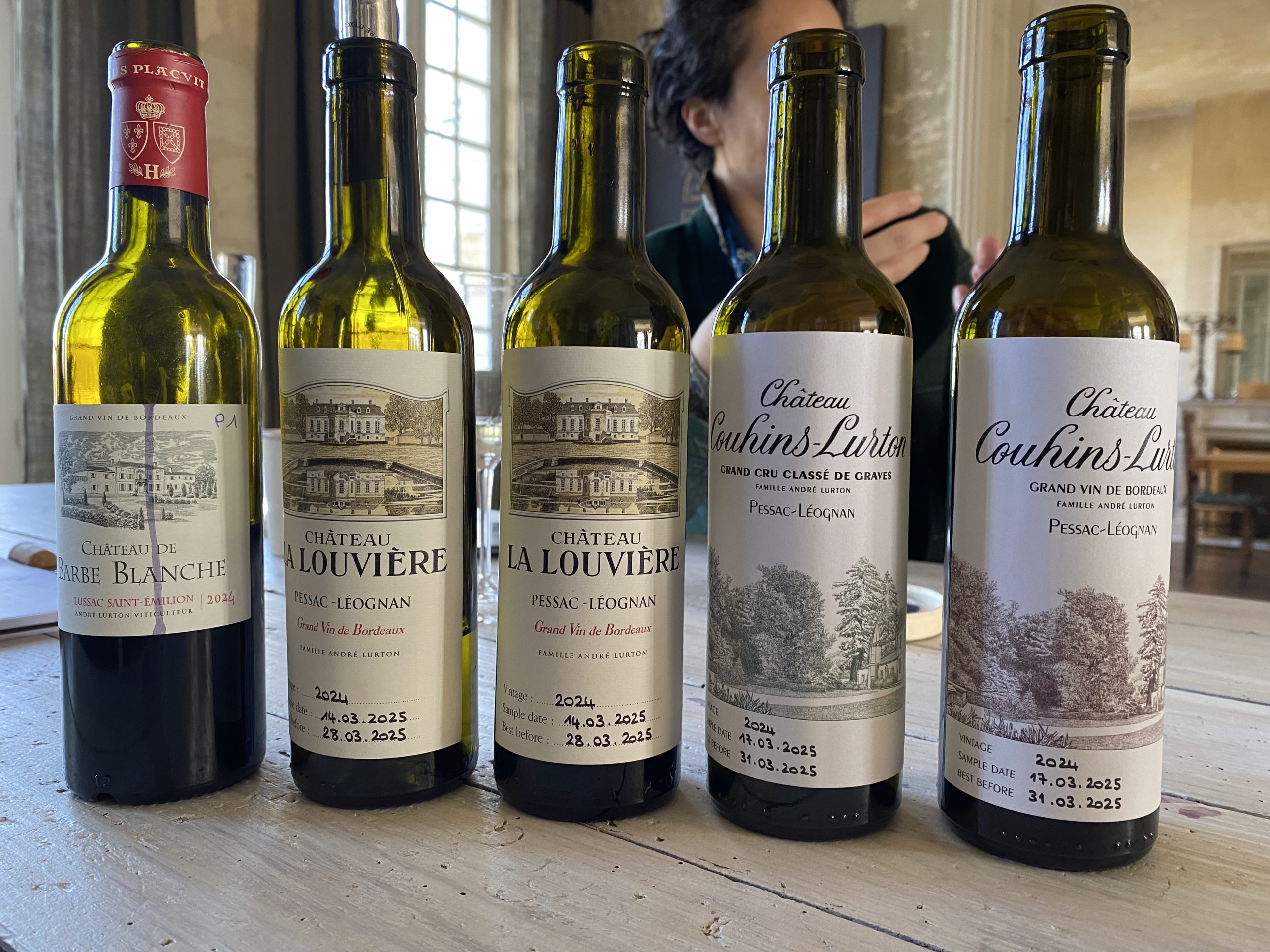
 A note on the ratings
Alongside the published tasting notes is an indicative rating for each wine and although both comments and ratings are subjective, I would urge you to look at the two together and, if anything, to privilege the comment over the rating. My aim is more to describe the wine in the context of the vintage, the appellation and recent vintages of the same and similar wines, rather than to judge the wine per se.
The ratings reflect my subjective evaluations and relative preferences between wines and obviously your palate is likely to differ from mine. But I hope my comments give you at least enough information to be able to recalibrate my ratings and, in so doing, to align them more closely to your own palate
2024, like both of its predecessors is far from a homogeneous vintage and, consequently, my ratings span a considerable range. I see little interest, either for the consumer or the producer, in publishing very low scores, so I have decided not to publish scores for classed growths (or equivalent wines) rated below 90 (or 89-91 as a range) and for crus bourgeois (or their equivalents) rated below 88 (or 87-89). Where no rating is published, the wine would have scored below these thresholds.
Finally, élevage is likely to be very important in determining the quality in bottle of these wines. I am no soothsayer and cannot predict how that will turn out (another reason for the use of banded ratings). But all en primeur ratings should be treated with caution and taken with a certain pinch of salt.
Detailed tasting notes (from over 100 wines tasted)
A note on the ratings
Alongside the published tasting notes is an indicative rating for each wine and although both comments and ratings are subjective, I would urge you to look at the two together and, if anything, to privilege the comment over the rating. My aim is more to describe the wine in the context of the vintage, the appellation and recent vintages of the same and similar wines, rather than to judge the wine per se.
The ratings reflect my subjective evaluations and relative preferences between wines and obviously your palate is likely to differ from mine. But I hope my comments give you at least enough information to be able to recalibrate my ratings and, in so doing, to align them more closely to your own palate
2024, like both of its predecessors is far from a homogeneous vintage and, consequently, my ratings span a considerable range. I see little interest, either for the consumer or the producer, in publishing very low scores, so I have decided not to publish scores for classed growths (or equivalent wines) rated below 90 (or 89-91 as a range) and for crus bourgeois (or their equivalents) rated below 88 (or 87-89). Where no rating is published, the wine would have scored below these thresholds.
Finally, élevage is likely to be very important in determining the quality in bottle of these wines. I am no soothsayer and cannot predict how that will turn out (another reason for the use of banded ratings). But all en primeur ratings should be treated with caution and taken with a certain pinch of salt.
Detailed tasting notes (from over 100 wines tasted)
 Château Couhins Lurton blanc 2024 (Pessac-Léognan; 100% Sauvignon Blanc; a final yield of 41 ha/ha; 13% alcohol; Valérie Lavigne is the consultant here as for La Louvière; tasted twice, first at the property). More wild in its aromatics than, say, La Louvière. Almost a touch of tomato stalk and redcurrant and white currant leaf. Lemon meringue pie. Citron pressé. White grapefruit. Delicate white spring flowers. Jasmine too and a little elderberry. Green tea leaf, almost a hint of toasted rice. There’s salinity even on the nose. So intense and compact and structurally tense. Really juicy and fresh and sapid. This is the style of Pessac that I really love, with no demonstrative hint of the oak. Great aging potential. A vintage that really shows off the style of this terroir – so racy and fresh and bright and vividly energetic. The limestone bedrock here really sings! 93-95.
Domaine de Chevalier blanc (Pessac-Léognan; 75% Sauvignon Blanc; 25% Sémillon; a final yield of 48 hl/ha; pH 3.13; 12.8% alcohol; tasted twice, first at the UGC press tasting at the Cité du Vin). This is lovely. Distinctive, aromatically, with white flowers, nectarine, pear and white melon flesh accompanied by pink grapefruit, blood orange, orange blossom and honeysuckle. There’s a little note of blanched almond and also the creaminess that comes with that. Fine and delicate in the mouth, with a layered sapid freshness but also plenty of density and viscosity (if not that of some recent vintages), rendering this highly tactile and all the more engaging for that. Taut and tense, racy and vibrant. 93-95.
Château Ferrande blanc (Pessac-Léognan; 40% Sauvignon Gris; 36% Sémillon; 24% Sauvignon Blanc; pH 3.3; 12.5% alcohol; tasted twice, first at the UGC press tasting at the Cité du Vin and then at Montlabert; Julien Belle from Oenoteam is the consultant here; certified organic). In comparison with de Chantegrive (tasted just before) this seems to have more Sémillon, giving richness and also greater fruit complexity. Pretty aromatically, with peach, nectarine, apricot skin and assorted bitingly fresh citrus notes – citron pressé but also confit lemon and even lemon meringue pie, passionfruit and guava, and those little Sauternais notes so characteristic of this vintage. This is lithe, engaging and dynamic in the mouth, sapid and juicy on the finish. 90-92+.
Château de Fieuzal blanc (Pessac-Léognan; 70% Sauvignon Blanc; 30% Sémillon; a final yield of 40 ha/ha; alcohol; tasted twice, first with Stephen Carrier at the property a week after the final assemblage). Very true to its style. Waxy, open-textured, very fine and refined. Saffron, yellow flowers, buttercups. Acacia. A little toasted almonds. Mimosa. Elderflower. Even a little rose petal. There’s lovely hint of peach, peach stone and apricot. Stricter than the 2022 and more like the 2021 in a way, this is beautifully shaped – an hourglass on its side. Tender. Fluid. Beautifully sustained by the granular acidity, rippling towards the finish and then releasing sapidity and juiciness. Very pure yet with a certain opulence despite the structuring and structural acidity. Less strict than many of the wines of the vintage and more aerial and ethereal for that. 93-95.
Clos Floridène blanc (Graves; 55% Sémillon; 45% Sauvignon Blanc; 13% alcohol). Ample on the attack and layered, almost like a cascading cliff face made of well-defined vertical strata, each here interspersed with juicy, sapid confit and freshly squeezed citrus notes. Radiant and luxurious in its precision and in its glassy mid-palate this is likely to prove exceptional value – not for the first time. 90-92.
Château de France blanc (Pessac-Léognan; 80% Sauvignon Blanc; 20% Sémillon; a final yield of 40 hl/ha; 13% alcohol; tasted first at the UGC press tasting at the Cité du Vin). Lithe and limpid, racy and energetic, with the tension and tautness that is the signature of this wine reinforced by the relatively narrow frame. Not terribly complex, but finely judged and accessible immediately. 89-91.
Château La Garde blanc (Pessac-Léognan; 93% Sauvignon Blanc; 7% Sémillo; 13% alcohol; Axel Marchal is the consultant here). Interesting aromatically. Eucalyptus. Incense. Ginger – fresh and confit. Apple, peach, apricot and nectarine, and then 50 shades of citrus. This has a pleasing sense of structural tension, reinforced by the gentle touch of tannin on the finish. Super sapid on the finish. 91-93.
Château Haut-Brion blanc (Pessac-Léognan; 56.1% Sémillon; 43.9% Sauvignon Blanc; pH 3.22; a final yield of 38 hl/ha; 13.75% alcohol; tasted at La Mission Haut-Brion). Orange blossom. Jasmine. Candlewax. Richer, fuller, maybe a little less ample in frame and with more profundity as a consequence, this is a grand vin blanc de garde. Green tea notes, with a little yuzu, some exotic guava and even mango notes. Rich, full and viscous but in this vintage never lacking in freshness and incisive acidity. Tender and more grippy on the finish that La Mission blanc, but actually richer too. Quite toasty for a young Haut-Brion. Assorted white fleshy fruits – pear and pear belle Helene and also a little, but very subtle, note of apricot and nectarine, even the suggestion of wild strawberry. I like the cascading ripples of freshness that seem to descend from above. Saline on the finish. 94-96.
Les Hauts de Smith (Pessac-Léognan; 100% Sauvignon Blanc; 50% new oak; tasted at the property). Glassy, glossy, rich and dense but hyper-fresh and intensely sapid and juicy. Easy, not especially complex I guess, but wondrously refreshing and impressively viscous in the mouth too. Excellent at this level and at its likely price point. Crunchy white fruits and citron pressé. 90-92.
Château Larrivet Haut-Brion (Pessac-Léognan; 84% Sauvignon Blanc; 16% Sémillon; 13% alcohol; tasted twice, first at the UGC press tasting at the Cité du Vin). This is excellent and rather different. Peach and nectarine, a hint of wild strawberry, wild spring hedgerow flowers, fennel tops, freshly cut grass and a hint of exoticism – guava and passionfruit, passionflower too. Freshly grated ginger. But also a distinct oak smoke note. Intense, lifted and aerial and very vertical in its mouthfeel, with a lovely grip from the trace of tannin as an undertone. I like this a lot. 93-95.
Château Latour Martillac blanc (Pessac-Léognan; 60% Sauvignon Blanc; 40% Sémillon; a final yield of 52 hl/ha; 12.5% alcohol; tasted twice, first at the UGC press tasting at the Cité du Vin). Jasmine, honeysuckle, apricot and nectarine, citron pressé and tarte au citron. A little blanched almond and also fennel fronds. This is exquisite and, rather like Larrivet Haut-Brion tasted alongside, it has a very vertical, almost hour-glass shape in the mouth. Tactile and dynamic and ultra-refreshing in its sapidity, this is a great success. I love the zestiness of the finish. 93-95.
Château La Louvière blanc (Pessac-Léognan; 100% Sauvignon Blanc; a final yield of 43 ha/ha; 13% alcohol; Valérie Lavigne is the consultant here; tasted first at the property, then at the UGC press tasting). Apple core. White grapefruit. A little white peach flesh – just à point. Nettle and greengage. Lemon confit. White flowers. This is richer aromatically than Couhins Lurton but it takes a while to open fully. It’s fleshier on the palate and with a slightly more open texture too. Crystalline, fresh, pure and very well defined in its linearity with a clear and evident central spine. Zesty. Clementine peel. Very fresh and gloriously sapid, with a lovely salinity to the finish. This already has me craving oysters. 91-93+.
Château Malartic-Lagravière blanc (Pessac-Léognan; 69% Sauvignon Blanc; 31% Sémillon; a final yield of 41 hl/ha; 40% new oak; pH 3.28; 12.5% alcohol; tasted at the property with Severine and Jean-Jacques Bonnie and then re-tasted at the UGC press tasting). Beautifully true to its style and an easy pick. Upright, tense and charged with energy. A touch of iodine and oyster shell, gooseberry, greengage and Mirabelle, green tea, white almond. Apple skin. This has great impact on the attack with lots of vertical range and layering for a white. Some exotic fruits– guava and passionfruit – but predominantly citrus notes, with blood orange, mandarin rind, yuzu and pink grapefruit; white pear and nectarine too. A little fennel bulb. This has a lovely subtle salinity on the finish too. Long and gently tapering. lhere’s pots of aging potential to this but it’s already highly accessible – frankly, deliciously crisp. Apple skin on the finish and a gentle touch of tannin. 92-94.
Clos Marsalette Blanc (Pessac-Léognan; 54% Sauvignon Blanc; 46% Sémillon; a final yield of 50 hl/ha; 13% alcohol; tasted at Canon-La-Gaffelière). This has a lovely ample frame, once again, but it’s also hyper-fresh and gloriously energetic and fruity. The Sémillon brings a lovely pure peach fruit and lots of succulence with it. Apple skins. Confit lemon. White melon. A touch of passionflower too. Enticing and racy. Salivating in its sapidity. 90-92+.
Château La Mission Haut-Brion blanc (Pessac-Léognan; 5% Sémillon; 41% Sauvignon Blanc; pH 3.25; a final yield of 38 hl/ha; 13.75% alcohol; tasted at the property). Linden. Lime leaf. Lime zest. Elderflower and even a little elderberry. Cathedral candles and the plume of smoke from the candle snuffer. White pear. A touch of guava – a note that returns on the palate and that slight La Mission exoticism that could almost have us in the kingdom of Sauternes in terms of fruit descriptors. This is crystalline in its purity and precision, radiant and dynamic in the flow of the fruit and the sapidity of the up-flows and resulting eddies of freshness to be discovered in the mid-palate. Very beautiful and very poised, but at the same time a vin de garde that one really needs to cellar. Fresher and more energetic in than freshness and sapidity than Haut-Brion, fresher still with more zest and vim from a second bottle newly opened. 95-97.
Château Olivier blanc (Pessac-Léognan; 80% Sémillon; 20% Sauvignon Blanc; a final yield of 51 hl/ha; 13% alcohol; tasted twice, first at the UGC press tasting at the Cité du Vin). Orange blossom, honeysuckle, a hint of saffron and a cascade of citrus. A little confit melon too. Very crisp and bright, energetic and aerial, yet with a lovely sense of structure, forged as much by the acidity as by anything else. This has a pronounced sense of freshness like a firehose pointed upwards in the mouth spraying juicy sapidity so that it descends down the cheeks. A lovely harmony. 92-94.
Château Pape Clément blanc (Pessac-Léognan; 50% Sauvignon Blanc; 43% Sémillon; 7% Sauvignon Gris; a final yield of 37 hl/ha, just a little below the appellation average; tasted twice, first at the UGC press tasting). Wonderfully true to its style and simply wonderful once again in this vintage. We’ve got a lot more of the exotic notes of the vintage here – guava and pineapple, alongside the more conventional nectarine and white melon, lime and lemon zest and a hint of floral honey and saffron. A signature Pape Clément hint of beeswax. This makes a stark contrast to the grippier, more citrus-oriented and chiselled style of Couhins and Couhins Lurton, but you really want to taste them all. Splendidly juicy and energising in its freshness – that cuts the richness so successfully. That is sometimes my issue with Pape Clément, but not at all in this vintage. 94-96.
Le Petit Smith Haut-Lafitte (Pessac-Léognan; 80% Sauvignon Blanc; 20% Sémillon; 50% new oak; tasted at the property). Le Petit is Grand in 2024, un grand vin de table! Granny Smith apple! Iodine, oyster shell, linden, lime and assorted fresh and confit citrus notes. A touch of confit lemon too. Really ample and pushing at the cheeks, like it’s bigger sibling. Lovely sapidity with little plumes of fresh citrus descending like tears down the side of the wine glass. 91-93.
Château Picque Caillou blanc (Pessac-Léognan; 100% Sauvignon Blanc; a final yield of 36 hl/ha; 13% alcohol; tasted twice, first at the UGC press tasting at the Cité du Vin). A wine with the misfortune of coming immediately after Pape Clément in alphabetical order in the UGC tasting, but here it shows really well. Pear, pear belle Hélène, blood orange and orange blossom, even a trace of wild strawberry. I love the gentle viscosity – the texture of the finest tomato consommé and, like that, there’s just a hint of tannin on the finish that I really find enticing. Poised, lithe, delicately balanced and very refined. As good a vintage of this as I can recall. 92-94.
Château Smith Haut-Lafitte (Pessac-Léognan; 90% Sauvignon Blanc; 5% Sémillon; 5% Sauvignon Gris; a final yield of 32 hl/ha because of the early mildew pressure; 50% new oak; tasted twice, first at the property and then at the UGC press tasting). Wax candles. Linden. Lime. Jasmine. White floral notes – jasmine and elderflower, a little orange blossom too. Green tea and yuzu. A little peach skin, Granny Smith peel and just a hint of guava in all its essential freshness. Structured by the acidity and a little tannin. Even Macha. No signature of the oak, or very little – just a hint of spice. White peach and the texture of the skin – very tactile. So sapid and juicy. One of the best wines ever from here. A pinch from the tannins and then a release of salinity and even a little sweetness. 95-97.
Château Couhins Lurton blanc 2024 (Pessac-Léognan; 100% Sauvignon Blanc; a final yield of 41 ha/ha; 13% alcohol; Valérie Lavigne is the consultant here as for La Louvière; tasted twice, first at the property). More wild in its aromatics than, say, La Louvière. Almost a touch of tomato stalk and redcurrant and white currant leaf. Lemon meringue pie. Citron pressé. White grapefruit. Delicate white spring flowers. Jasmine too and a little elderberry. Green tea leaf, almost a hint of toasted rice. There’s salinity even on the nose. So intense and compact and structurally tense. Really juicy and fresh and sapid. This is the style of Pessac that I really love, with no demonstrative hint of the oak. Great aging potential. A vintage that really shows off the style of this terroir – so racy and fresh and bright and vividly energetic. The limestone bedrock here really sings! 93-95.
Domaine de Chevalier blanc (Pessac-Léognan; 75% Sauvignon Blanc; 25% Sémillon; a final yield of 48 hl/ha; pH 3.13; 12.8% alcohol; tasted twice, first at the UGC press tasting at the Cité du Vin). This is lovely. Distinctive, aromatically, with white flowers, nectarine, pear and white melon flesh accompanied by pink grapefruit, blood orange, orange blossom and honeysuckle. There’s a little note of blanched almond and also the creaminess that comes with that. Fine and delicate in the mouth, with a layered sapid freshness but also plenty of density and viscosity (if not that of some recent vintages), rendering this highly tactile and all the more engaging for that. Taut and tense, racy and vibrant. 93-95.
Château Ferrande blanc (Pessac-Léognan; 40% Sauvignon Gris; 36% Sémillon; 24% Sauvignon Blanc; pH 3.3; 12.5% alcohol; tasted twice, first at the UGC press tasting at the Cité du Vin and then at Montlabert; Julien Belle from Oenoteam is the consultant here; certified organic). In comparison with de Chantegrive (tasted just before) this seems to have more Sémillon, giving richness and also greater fruit complexity. Pretty aromatically, with peach, nectarine, apricot skin and assorted bitingly fresh citrus notes – citron pressé but also confit lemon and even lemon meringue pie, passionfruit and guava, and those little Sauternais notes so characteristic of this vintage. This is lithe, engaging and dynamic in the mouth, sapid and juicy on the finish. 90-92+.
Château de Fieuzal blanc (Pessac-Léognan; 70% Sauvignon Blanc; 30% Sémillon; a final yield of 40 ha/ha; alcohol; tasted twice, first with Stephen Carrier at the property a week after the final assemblage). Very true to its style. Waxy, open-textured, very fine and refined. Saffron, yellow flowers, buttercups. Acacia. A little toasted almonds. Mimosa. Elderflower. Even a little rose petal. There’s lovely hint of peach, peach stone and apricot. Stricter than the 2022 and more like the 2021 in a way, this is beautifully shaped – an hourglass on its side. Tender. Fluid. Beautifully sustained by the granular acidity, rippling towards the finish and then releasing sapidity and juiciness. Very pure yet with a certain opulence despite the structuring and structural acidity. Less strict than many of the wines of the vintage and more aerial and ethereal for that. 93-95.
Clos Floridène blanc (Graves; 55% Sémillon; 45% Sauvignon Blanc; 13% alcohol). Ample on the attack and layered, almost like a cascading cliff face made of well-defined vertical strata, each here interspersed with juicy, sapid confit and freshly squeezed citrus notes. Radiant and luxurious in its precision and in its glassy mid-palate this is likely to prove exceptional value – not for the first time. 90-92.
Château de France blanc (Pessac-Léognan; 80% Sauvignon Blanc; 20% Sémillon; a final yield of 40 hl/ha; 13% alcohol; tasted first at the UGC press tasting at the Cité du Vin). Lithe and limpid, racy and energetic, with the tension and tautness that is the signature of this wine reinforced by the relatively narrow frame. Not terribly complex, but finely judged and accessible immediately. 89-91.
Château La Garde blanc (Pessac-Léognan; 93% Sauvignon Blanc; 7% Sémillo; 13% alcohol; Axel Marchal is the consultant here). Interesting aromatically. Eucalyptus. Incense. Ginger – fresh and confit. Apple, peach, apricot and nectarine, and then 50 shades of citrus. This has a pleasing sense of structural tension, reinforced by the gentle touch of tannin on the finish. Super sapid on the finish. 91-93.
Château Haut-Brion blanc (Pessac-Léognan; 56.1% Sémillon; 43.9% Sauvignon Blanc; pH 3.22; a final yield of 38 hl/ha; 13.75% alcohol; tasted at La Mission Haut-Brion). Orange blossom. Jasmine. Candlewax. Richer, fuller, maybe a little less ample in frame and with more profundity as a consequence, this is a grand vin blanc de garde. Green tea notes, with a little yuzu, some exotic guava and even mango notes. Rich, full and viscous but in this vintage never lacking in freshness and incisive acidity. Tender and more grippy on the finish that La Mission blanc, but actually richer too. Quite toasty for a young Haut-Brion. Assorted white fleshy fruits – pear and pear belle Helene and also a little, but very subtle, note of apricot and nectarine, even the suggestion of wild strawberry. I like the cascading ripples of freshness that seem to descend from above. Saline on the finish. 94-96.
Les Hauts de Smith (Pessac-Léognan; 100% Sauvignon Blanc; 50% new oak; tasted at the property). Glassy, glossy, rich and dense but hyper-fresh and intensely sapid and juicy. Easy, not especially complex I guess, but wondrously refreshing and impressively viscous in the mouth too. Excellent at this level and at its likely price point. Crunchy white fruits and citron pressé. 90-92.
Château Larrivet Haut-Brion (Pessac-Léognan; 84% Sauvignon Blanc; 16% Sémillon; 13% alcohol; tasted twice, first at the UGC press tasting at the Cité du Vin). This is excellent and rather different. Peach and nectarine, a hint of wild strawberry, wild spring hedgerow flowers, fennel tops, freshly cut grass and a hint of exoticism – guava and passionfruit, passionflower too. Freshly grated ginger. But also a distinct oak smoke note. Intense, lifted and aerial and very vertical in its mouthfeel, with a lovely grip from the trace of tannin as an undertone. I like this a lot. 93-95.
Château Latour Martillac blanc (Pessac-Léognan; 60% Sauvignon Blanc; 40% Sémillon; a final yield of 52 hl/ha; 12.5% alcohol; tasted twice, first at the UGC press tasting at the Cité du Vin). Jasmine, honeysuckle, apricot and nectarine, citron pressé and tarte au citron. A little blanched almond and also fennel fronds. This is exquisite and, rather like Larrivet Haut-Brion tasted alongside, it has a very vertical, almost hour-glass shape in the mouth. Tactile and dynamic and ultra-refreshing in its sapidity, this is a great success. I love the zestiness of the finish. 93-95.
Château La Louvière blanc (Pessac-Léognan; 100% Sauvignon Blanc; a final yield of 43 ha/ha; 13% alcohol; Valérie Lavigne is the consultant here; tasted first at the property, then at the UGC press tasting). Apple core. White grapefruit. A little white peach flesh – just à point. Nettle and greengage. Lemon confit. White flowers. This is richer aromatically than Couhins Lurton but it takes a while to open fully. It’s fleshier on the palate and with a slightly more open texture too. Crystalline, fresh, pure and very well defined in its linearity with a clear and evident central spine. Zesty. Clementine peel. Very fresh and gloriously sapid, with a lovely salinity to the finish. This already has me craving oysters. 91-93+.
Château Malartic-Lagravière blanc (Pessac-Léognan; 69% Sauvignon Blanc; 31% Sémillon; a final yield of 41 hl/ha; 40% new oak; pH 3.28; 12.5% alcohol; tasted at the property with Severine and Jean-Jacques Bonnie and then re-tasted at the UGC press tasting). Beautifully true to its style and an easy pick. Upright, tense and charged with energy. A touch of iodine and oyster shell, gooseberry, greengage and Mirabelle, green tea, white almond. Apple skin. This has great impact on the attack with lots of vertical range and layering for a white. Some exotic fruits– guava and passionfruit – but predominantly citrus notes, with blood orange, mandarin rind, yuzu and pink grapefruit; white pear and nectarine too. A little fennel bulb. This has a lovely subtle salinity on the finish too. Long and gently tapering. lhere’s pots of aging potential to this but it’s already highly accessible – frankly, deliciously crisp. Apple skin on the finish and a gentle touch of tannin. 92-94.
Clos Marsalette Blanc (Pessac-Léognan; 54% Sauvignon Blanc; 46% Sémillon; a final yield of 50 hl/ha; 13% alcohol; tasted at Canon-La-Gaffelière). This has a lovely ample frame, once again, but it’s also hyper-fresh and gloriously energetic and fruity. The Sémillon brings a lovely pure peach fruit and lots of succulence with it. Apple skins. Confit lemon. White melon. A touch of passionflower too. Enticing and racy. Salivating in its sapidity. 90-92+.
Château La Mission Haut-Brion blanc (Pessac-Léognan; 5% Sémillon; 41% Sauvignon Blanc; pH 3.25; a final yield of 38 hl/ha; 13.75% alcohol; tasted at the property). Linden. Lime leaf. Lime zest. Elderflower and even a little elderberry. Cathedral candles and the plume of smoke from the candle snuffer. White pear. A touch of guava – a note that returns on the palate and that slight La Mission exoticism that could almost have us in the kingdom of Sauternes in terms of fruit descriptors. This is crystalline in its purity and precision, radiant and dynamic in the flow of the fruit and the sapidity of the up-flows and resulting eddies of freshness to be discovered in the mid-palate. Very beautiful and very poised, but at the same time a vin de garde that one really needs to cellar. Fresher and more energetic in than freshness and sapidity than Haut-Brion, fresher still with more zest and vim from a second bottle newly opened. 95-97.
Château Olivier blanc (Pessac-Léognan; 80% Sémillon; 20% Sauvignon Blanc; a final yield of 51 hl/ha; 13% alcohol; tasted twice, first at the UGC press tasting at the Cité du Vin). Orange blossom, honeysuckle, a hint of saffron and a cascade of citrus. A little confit melon too. Very crisp and bright, energetic and aerial, yet with a lovely sense of structure, forged as much by the acidity as by anything else. This has a pronounced sense of freshness like a firehose pointed upwards in the mouth spraying juicy sapidity so that it descends down the cheeks. A lovely harmony. 92-94.
Château Pape Clément blanc (Pessac-Léognan; 50% Sauvignon Blanc; 43% Sémillon; 7% Sauvignon Gris; a final yield of 37 hl/ha, just a little below the appellation average; tasted twice, first at the UGC press tasting). Wonderfully true to its style and simply wonderful once again in this vintage. We’ve got a lot more of the exotic notes of the vintage here – guava and pineapple, alongside the more conventional nectarine and white melon, lime and lemon zest and a hint of floral honey and saffron. A signature Pape Clément hint of beeswax. This makes a stark contrast to the grippier, more citrus-oriented and chiselled style of Couhins and Couhins Lurton, but you really want to taste them all. Splendidly juicy and energising in its freshness – that cuts the richness so successfully. That is sometimes my issue with Pape Clément, but not at all in this vintage. 94-96.
Le Petit Smith Haut-Lafitte (Pessac-Léognan; 80% Sauvignon Blanc; 20% Sémillon; 50% new oak; tasted at the property). Le Petit is Grand in 2024, un grand vin de table! Granny Smith apple! Iodine, oyster shell, linden, lime and assorted fresh and confit citrus notes. A touch of confit lemon too. Really ample and pushing at the cheeks, like it’s bigger sibling. Lovely sapidity with little plumes of fresh citrus descending like tears down the side of the wine glass. 91-93.
Château Picque Caillou blanc (Pessac-Léognan; 100% Sauvignon Blanc; a final yield of 36 hl/ha; 13% alcohol; tasted twice, first at the UGC press tasting at the Cité du Vin). A wine with the misfortune of coming immediately after Pape Clément in alphabetical order in the UGC tasting, but here it shows really well. Pear, pear belle Hélène, blood orange and orange blossom, even a trace of wild strawberry. I love the gentle viscosity – the texture of the finest tomato consommé and, like that, there’s just a hint of tannin on the finish that I really find enticing. Poised, lithe, delicately balanced and very refined. As good a vintage of this as I can recall. 92-94.
Château Smith Haut-Lafitte (Pessac-Léognan; 90% Sauvignon Blanc; 5% Sémillon; 5% Sauvignon Gris; a final yield of 32 hl/ha because of the early mildew pressure; 50% new oak; tasted twice, first at the property and then at the UGC press tasting). Wax candles. Linden. Lime. Jasmine. White floral notes – jasmine and elderflower, a little orange blossom too. Green tea and yuzu. A little peach skin, Granny Smith peel and just a hint of guava in all its essential freshness. Structured by the acidity and a little tannin. Even Macha. No signature of the oak, or very little – just a hint of spice. White peach and the texture of the skin – very tactile. So sapid and juicy. One of the best wines ever from here. A pinch from the tannins and then a release of salinity and even a little sweetness. 95-97.







